

Le Tour de France Féminin de 1984 : Marianne Martin
7 septembre 2021 Laurent Inspiration , Au cœur du peloton 0

Le tout premier Tour de France féminin est organisé en 1984 dans une période où tout semble possible aux organisateurs. Ils ont su lever tous les obstacles logistiques et les barrages psychologiques pour rendre possible une course s’inscrivant dans le Tour de France. L’image de Marianne Martin sur le podium, aux côtés de Laurent Fignon, portant le même jaune de la victoire, est à ce point éloquente qu’on en oublie presque les différences de traitement entre les deux pelotons .
Marianne Martin remporte le premier Tour de France féminin, celui de 1984.
TOUR FEMININ 22 juillet 1984 Arrivée cet après-midi sur les Champs-Elysées du premier tour de France cycliste féminin, remportée par l’Américaine Marianne MARTIN.
Le Tour de France féminin : précisions
Même si c’est son histoire qui nous intéresse, certaines précisions méritent d’être données pour situer sa performance dans le contexte plus global du “Tour de France”.
Une organisation de la société du Tour
Le Tour de France Féminin n’a réellement existé que de 1984 à 1989, en “ lever de rideau ” (sic) du Tour de France masculin. Les étapes se déroulent en même temps que celles des hommes. Les distances sont plus courtes et les arrivées décalées. De 1989 à 1993, la Société du Tour de France organise un Tour de la CEE féminin.
En 1992, un Tour cycliste féminin est organisé une autre date que celui des hommes. Il change de nom en 1998 pour devenir la Grande Boucle Féminine . L’organisateur du Tour féminin ne peut employer le terme “Tour” qui est la propriété de la société du Tour de France
Sources, l’excellent site internet “ Mémoire du cyclisme ” qui compile des informations précieuses sur les femmes cyclistes.
Le Tour de France féminin de 1984
Pour la première édition du Tour de France féminin , 36 femmes de 4 nationalités s’élancent pour un parcours de 1067 kilomètres en 18 étapes de 50 à 80 km chacune. Le Tour comporte un contre-la-montre de 23 km. Elles seront 35 classées après avoir parcouru la distance à 36 km/h de moyenne.
Marianne Martin remporte le classement général avec 3 minutes et 17 secondes d’avance sur la seconde, Hélène Hage, une Néerlandaise. Une victoire acquise, principalement, lors des étapes de montagne .
Et c’est ainsi, que le 22 juillet 1984, Marianne Martin monte sur le podium, aux côtés de Laurent Fignon, rayonnants tous les deux devant la foule et les médias du monde entier. L’image est puissante , une femme et un homme côte à côte, tous deux en jaune, tous deux vainqueurs du Tour de France.
Marianne Martin
Marianne Martin est la première américaine à gagner un Tour de France. Avant Greg Lemond.
Des méthodes novatrices
Elle était cavalière avant de se mettre au vélo, à la suite d’une chute. Elle met quelques années avant de devenir une cycliste de haut niveau. Non seulement elle apprend à pédaler mais elle s’intéresse aux méthodes lui permettant d’optimiser la performance. Elle intègre la préparation mentale dans les dispositifs d’entraînement et réfléchit aux moyens pour améliorer la récupération .
Un mental d’acier
En 1984, elle intègre l’équipe nationale Américaine qui va participer au premier Tour de France Féminin. Pourtant n’étant pas leader de l’équipe ni favorite de l’épreuve, elle reste, toutefois, sûre d’elle, armée mentalement et bonne grimpeuse . Elle confie, d’ailleurs, à l’entraîneur de l’équipe : “Croyez-moi, vous ne serez pas déçu.”
Le déroulement de la course
Ces femmes cyclistes ont suivi le même parcours que les hommes. 18 étapes, mais les premières parties du parcours ont été conçues pour raccourcir la distance. Les étapes du Tour de France Féminin se terminaient chaque jour deux heures avant les hommes et profitaient donc de la même foule. Marianne Martin se souvient que les organisateurs de la course avaient à cœur de retirer le plus rapidement possible le peloton féminin de la zone d’arrivée. Il y avait peu d’interaction avec les hommes. On peut supposer qu’il était question de logistique.
Des victoires en montagne
Dès les premières étapes, l’équipe Néerlandaise domine. Heleen «Keetie» Hage devient leader de la course. Mais au fur et à mesure, les capacités de récupération de Martin et ses prouesses de grimpeuses deviennent déterminantes. Elle prend le maillot jaune à l’étape 14, et son avance est finalement décisive.
Marianne Martin remporte le classement général, celui de meilleur grimpeur. L’ équipe Américaine gagne le classement général par équipe et Deborah Shumway rejoint Marianne Martin sur le podium, troisième.
Et le Tour de France féminin
Quant à lui, le Tour de France Féminin continue sur le même format jusqu’en 1989. Ensuite, il change de nom, de format, d’organisateurs pour ne plus être grand chose aujourd’hui.
C’était il y a 34 ans
Ce qui ne cesse de nous étonner, c’est que 34 ans auparavant, ce Tour de France ait pu avoir lieu. Les moyens de communication étaient moins développés qu’aujourd’hui et par voie de conséquence, la couverture médiatique était moindre aussi, sans le rôle que les réseaux sociaux peuvent jouer aujourd’hui pour palier aux insuffisances des médias traditionnels.
Que s’est-il passé en 1984 , pour qu’un Tour de France Féminin ait pu avoir lieu ? Pour trouver la réponse, il est nécessaire de croiser un certain nombre de facteurs à la fois conjoncturels, économiques et sociaux.
De nouvelles idées pour le Tour de France
Il faut bien avouer qu’à la fin des années 70, le Tour de France sort d’une période difficile. L’intérêt économique diminue. Par exemple, en 1974, il n’y a plus que 4 équipes professionnelles qui participent. Le public est moins nombreux au bord des routes.
Au début des années 80, ses organisateurs commencent à peine à instaurer les recettes qui font son succès aujourd’hui : arrivée dans les stations de montagne, passage au cœur de la France, lien avec le terroir, utilisation de la télévision pour susciter l’intérêt, début de l’extension mondialisée (équipes et téléspectateurs)
Des changements dans la direction
En 1981, Félix Lévitan, directeur de la Société du Tour de France, s’assure les services du Colonel Richard Marillier . Ancien militaire, il a le sens de l’organisation mais aussi, il est très impliqué dans le fonctionnement de la Fédération Française de Cyclisme. Il fût de nombreuses années sélectionneur de l’équipe de France , de 1970 à 1981. Il a encadré les hommes qui ont fait les belles heures du cyclisme français. Cyrille Guimard, 3e du championnat du monde, Régis Ovion, champion du monde amateur, Raymond Poulidor et Mariano Martinez 2e et 3e du championnat du monde 1974, Bernard Hinault, champion du monde en 1980.
Le potentiel du cyclisme féminin
C’est aussi sous sa direction que Geneviève Gambillon (1972 et 1974) et Josiane Bost (1977) sont championnes du Monde sur route. En 1978, il voit naître la championne Jeannie Longo qui devient vice-championne du monde en 1981.
Élément de conjoncture également, une épreuve de cyclisme sur route est ouverte aux femmes, pour la première fois, aux Jeux Olympiques de 1984 à Los Angeles .
Des éléments de contexte
Un homme qui connaît bien le cyclisme, une épreuve qui doit évoluer, des échéances olympiques imminentes sont autant d’éléments qui vont concourir à la création du Tour de France en 1984. Le contexte politique y est, sûrement, pour quelque chose. En 1974, Valéry Giscard d’Estaing crée le tout premier secrétariat d’Etat à la condition féminine. Condition féminine n’est pas très heureux mais il résume, déjà, correctement, la situation des femmes à cette époque. En 1986, Laurent Fabius attribue à Yvette Roudy un ministère de plein exercice. Tout cela pour montrer qu’il y a une prise de conscience de la situation inégalitaire de la condition de la femme.
La condition de la femme cycliste
Ainsi, en 1984, Marianne Martin monte sur le podium sur les champs Elysées aux côtés de Laurent Fignon, Greg Lemond, Bernard Hinault et Robert Millar.
Ce peloton féminin a parcouru 18 étapes, passé la même ligne d’arrivée, reçu les encouragements des spectateurs, coincé entre le montage sur la ligne d’arrivée du podium et la caravane publicitaire . Les conditions de vie de ces cyclistes étaient précaires. Marianne Martin avoue qu’elle a gagné 1 000 dollars de son aventure en jaune qu’il a fallu partager entre les membres de l’équipe. Elle a payé son vol pour se rendre à Paris et financé tout son équipement.
Un désintérêt progressif
La course, elle, s’est progressivement éteinte, prise en étau entre des considérations logistiques et économiques. Il est vrai que le Tour de France est devenu une gigantesque machine économique parfaitement rodée. Elle ne laisse plus aucune place à l’improvisation.
Ce qu’en pense Christian Prudhomme
C’est ce que dit, tout au moins, Christian Prudhomme, le directeur du Tour de France, lors d’une interview sur la radio Europe 1 , le 30 juin 2019.
“Le Tour, ce sont 29.000 policiers, gendarmes et pompiers. Pensez-vous que nous puissions avoir un seul policier ou pompier supplémentaire pendant le mois de juillet ?” “[…] Vous vous rendez compte de ce que c’est ? Il y a deux hélicoptères télé, deux hélicoptères relais, un avion relais, les sept motos images, les deux motos sons. Tout ça en double ?”.
Avoir de l’audace
Et pour l’instant, ce Tour de France Féminin reste dans l’imaginaire des uns et des autres. Marianne Martin a eu la chance d’y participer est d’être la première à le remporter. Le monde change. Il laisse moins la place à l’improvisation, à la mise en oeuvre de projets audacieux, pour ne pas dire un peu fou. C’était dans les années 80.
Marianne Martin est, quant à elle, rentrée au pays, sa victoire éclipsée par la jeux Olympiques de Los Angeles et la victoire de l’Américaine Connie Carpenter. Ce tour de France fût le point culminant de sa carrière . Elle dirige aujourd’hui une entreprise de photographie. Elle ne roule plus à vélo. Elle garde un excellent souvenir de cette époque.
Marianne Martin – First American Winner Tour de France She was the first American to win the Tour de France. She was the first American to win a stage in the Tour. And she was the first to win the women’s Tour. She’s on of our HERoes. #WeRide
Articles similaires
Soyez le premier à commenter, poster un commentaire annuler la réponse.
Votre adresse de messagerie ne sera pas publiée.
Adresse de contact *
Save my name, email, and website in this browser for the next time I comment.
Copyright © 2024 | Thème WordPress par MH Themes
- off.road.cc
- Dealclincher
- Fantasy Cycling
Support road.cc
Like this site? Help us to make it better.
- Sportive and endurance bikes
- Gravel and adventure bikes
- Urban and hybrid bikes
- Touring bikes
- Cyclocross bikes
- Electric bikes
- Folding bikes
- Fixed & singlespeed bikes
- Children's bikes
- Time trial bikes
- Accessories - misc
- Computer mounts
- Bike bags & cases
- Bottle cages
- Child seats
- Lights - front
- Lights - rear
- Lights - sets
- Pumps & CO2 inflators
- Puncture kits
- Reflectives
- Smart watches
- Stands and racks
- Arm & leg warmers
- Base layers
- Gloves - full finger
- Gloves - mitts
- Jerseys - casual
- Jerseys - long sleeve
- Jerseys - short sleeve
- Shorts & 3/4s
- Tights & longs
- Bar tape & grips
- Bottom brackets
- Brake & gear cables
- Brake & STI levers
- Brake pads & spares
- Cassettes & freewheels
- Chainsets & chainrings
- Derailleurs - front
- Derailleurs - rear
- Gear levers & shifters
- Handlebars & extensions
- Inner tubes
- Quick releases & skewers
- Energy & recovery bars
- Energy & recovery drinks
- Energy & recovery gels
- Heart rate monitors
- Hydration products
- Hydration systems
- Indoor trainers
- Power measurement
- Skincare & embrocation
- Training - misc
- Cleaning products
- Lubrication
- Tools - multitools
- Tools - Portable
- Tools - workshop
- Books, Maps & DVDs
- Camping and outdoor equipment
- Gifts & misc
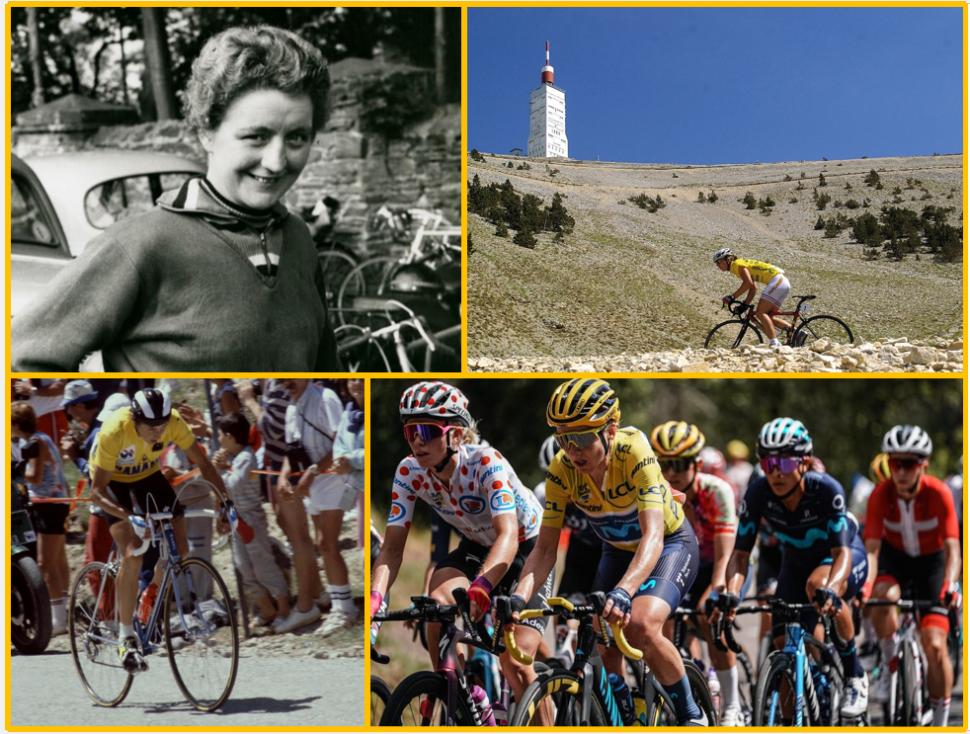
The Tour de France Femmes’ Long and Winding Road: A brief history of the women’s Tour de France
On Sunday morning, the peloton will roll out of Clermont-Ferrand for start of the second edition of the relaunched Tour de France Femmes. After the roaring success of the 2022 Tour Femmes, in terms of both the racing and the fervent roadside and television audience (recent data revealed that the race reached a cumulative audience of over 23 million people), expectations are high for an event that is already, just twelve months into its renaissance, an integral part of the women’s cycling calendar.
Not that the Tour de France Femmes is resting on its laurels, however. The 2023 edition appears keen to cast off the shackles of its association with the all-encompassing Tour Hommes – the Paris start, a kind of symbolic ‘handover’ from the men’s race, is already gone, replaced by some tough opening days in the Massif Central: a decision informed, race director Marion Rousse says, partly by a desire for the race to assert its independence, and partly to put together an interesting sporting test.
The groundbreaking narrative of the Tour de France Femmes – rhetoric commonly used throughout 2022’s ‘inaugural’ edition – continues at pace this year. The 2023 Tour de France Femmes, according to the official record, is again one of firsts. A first start away from Paris, a first venture in the Pyrenees (with a summit finish atop the iconic Col du Tourmalet, no less), and a first decisive final day time trial in Pau.
Because, if you were reading the official Tour preview, you’d be fooled into thinking – with the exception of one or two casual references to the 1980s – that everything began in 2022.
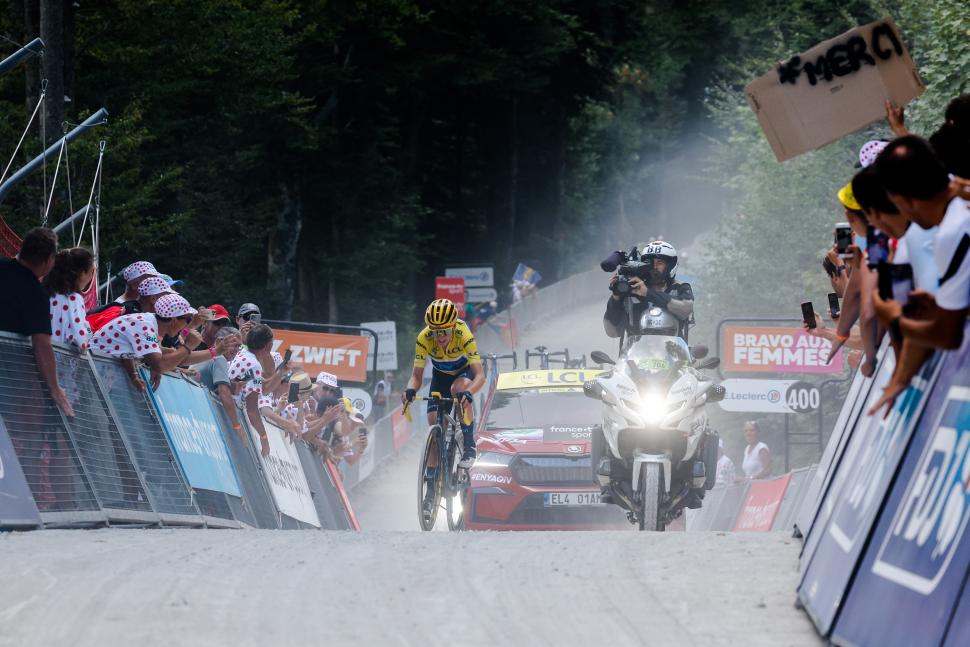
> History maker: Peerless Annemiek van Vleuten wins first edition of relaunched Tour de France Femmes
But the Tour de France Femmes avec Zwift (to give it its full title), as all those who fought to secure a stable, successful Tour de France for female riders will attest, forms part of a long history, one even more circuitous and taxing than the route the riders will face through the middle and south of France over the next eight days.
The long, hard fight
Because rather than a historic first, last year’s “inaugural” Tour de France Femmes was something of a rebirth, the culmination of a long fight to get something back, not gain something new.
The first women’s Tour de France was, in fact, held almost seven decades ago, in 1955. The race was the brainchild of journalist and sometime-team manager Jean Leulliot, who organised the infamous Circuit de France stage race in 1942 with the collaboration of the Nazis, and was the race director, and then owner, of Paris-Nice.
The inaugural Tour de France Féminin – only the second women’s stage race of its kind, after the Circuit Feminin Lyonnais-Auvergne was held earlier that year, in July – took place over five days in Normandy in September and October 1955.

It was won by Irish-born Isle of Man rider Millie Robinson, the winner of the Lyonnais-Auvergne race two months previously, who secured her historic (and largely forgotten) success via a late attack into Elbeuf on stage four and a dominant time trial performance – unsurprisingly, for someone from this part of the world – the following day.
However, despite the race’s apparent success, Leulliot quickly abandoned his experiment after just one edition.
Almost three decades later, in 1984, the idea was eventually revived by the Tour’s co-organiser Félix Lévitan. This time, the event much more closely resembled the men’s race and could properly be described, in the modern parlance, as a ‘grand tour’, and one which actually took the riders on a tour of France.
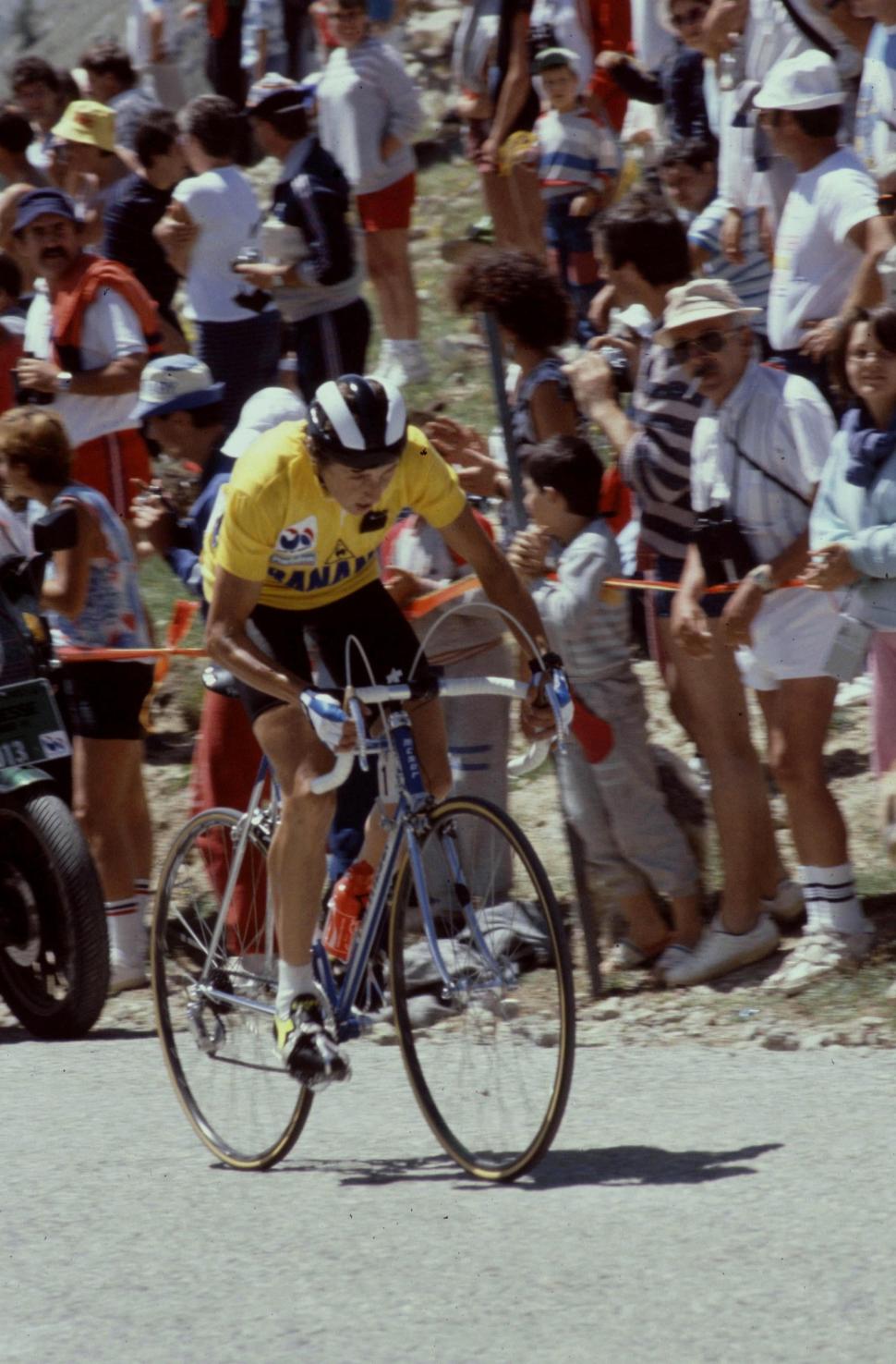
Two-time Tour Féminin winner Maria Canins climbs the Col d'Izoard during the 1986 race
The 1984 edition, held in the same summer as the inaugural women’s road race at the Olympic Games, took place over 18 days, with the women riding shortened versions of the men’s stages, including the iconic Alpine and Pyrenean passes such as the brutal Col de Joux Plane, earlier in the day.
That first-ever Tour de France Féminin, won by American Marianne Martin (two years before Greg LeMond became the country’s first male winner), kickstarted what was arguably the first ever golden age of women’s cycling.
Running concurrently with the men’s race meant that the pioneering women’s peloton were greeted by the same huge crowds, on the same iconic roads, while images of three-time winner Jeannie Longo – who enjoyed a brilliant rivalry with Italian double winner Maria Canins – on the final podium in Paris alongside Stephen Roche and LeMond, are embedded in the psyche of cycling fans of a certain vintage.

However, despite its links to the men’s event, the Tour de France Féminin retained an amateur-style, hard-scrabble feel, and was barely promoted beyond those taking part and the people they passed on the roadside. The ‘grand tour’ aspect of the race was also increasingly diluted as interest struggled to ignite – by 1989, it had been reduced to an 11-day race and was almost 300km shorter than its 1984 equivalent.
Following that 1989 edition, won once again by the dominant rider of her generation Longo, incoming Tour director Jean-Marie Leblanc scrapped the race, citing the commercial and financial concerns of running a race with limited media coverage and sponsorship (Leblanc missing the irony, clearly, of who was responsible for drumming up that interest).
Even more crucially, Leblanc and organisers ASO prevented other aspiring race planners from using the Tour de France trademark, ridding subsequent attempts at a women’s grand tour in France, such as the initial Tour of the EEC (first won in 1990 by four-time world champion Catherine Marshal) of much-needed legitimacy and exposure.
The trademark issue became a persistent thorn in the side for the event’s eventual successor, Pierre Boué’s Tour Cycliste Féminin (which later became known in 1998 as the Grande Boucle Féminine, after ASO complained, predictably, about the previous name).
Despite featuring long and tough stages, and some of France’s most iconic climbs (the 1995 edition included a finish on Alpe d’Huez) the Grande Boucle struggled to draw in sponsors and was dogged by organisational difficulties such as poor accommodation and unpaid prize money. The two-week race was missing from the calendar in 2004, and returned in a much-shortened format the following year.

The final edition of the Grande Boucle in 2009, won by Emma Pooley (the third British triumph in four years following Nicole Cooke’s successes in 2006 and 2007) was only four stages and 306.5km-long, prompting Pooley to memorably describe it as “more of a Petite Boucle”.
Not that there was anything “petite” about the riders’ performances, however. The first of Cooke’s back-to-back wins, in 2006, saw the future Olympic and world champion ride away solo in the yellow jersey on Mont Ventoux – a poignant site for British cycling – to secure a dominant victory.
Nevertheless, the demise of the Grande Boucle acted as a catalyst for a rethink – for a women’s Tour de France to be successful and sustainable, it had to have the backing of, you guessed it, the Tour de France.
In the late 2000s, a campaign was launched by pro cyclist, film maker, and writer Kathryn Bertine, who was later joined by Pooley, the sport’s new superstar Marianne Vos, and triathlete Chrissie Wellington, to convince Tour organisers ASO to put their weight behind a real women’s Tour de France.
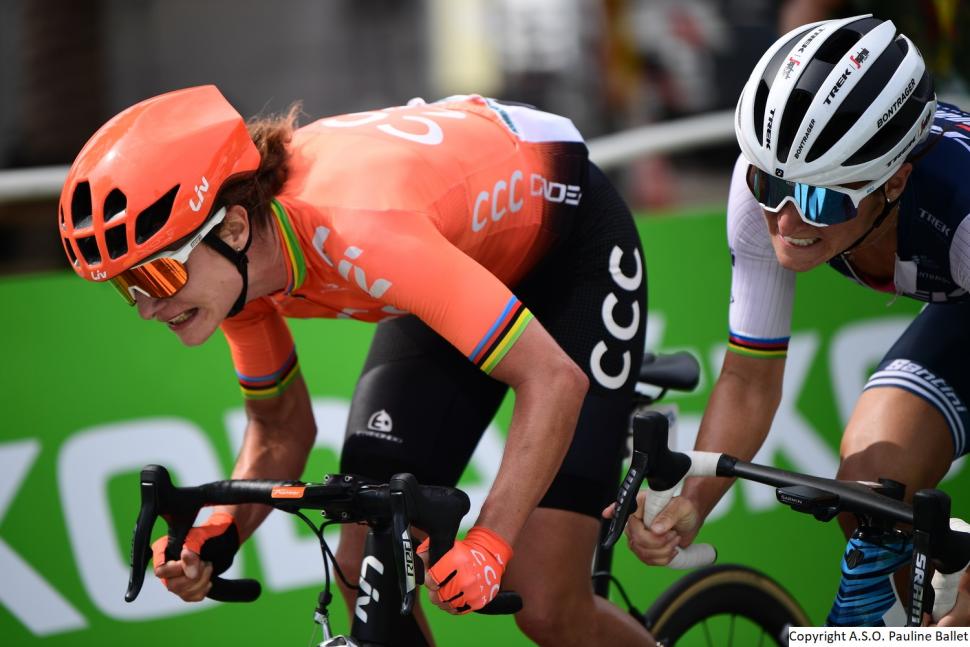
Lizzie Deignan outsprints Marianne Vos at the 2020 La Course
In 2014, the Tour organisers finally relented, to some degree, and came up with La Course by Le Tour de France. Originally held as a crit-style race around Paris on the same day as the final stage of the men’s race, the organisers then tinkered with a few mid-race experiments, while never expanding the event beyond two days.
Though La Course, and especially its first three years on the Champs-Élysées, felt at times like more of a concession than a statement of intent, a bolted-on afterthought rather than a sustainable plan for future growth, it nevertheless galvanised Bertine, Pooley, and Vos’s campaign for a proper, stable stage race under the Tour de France umbrella.
And with some scintillating racing to boot, especially once the race ventured beyond Paris – Annemiek van Vleuten’s stunning, last-ditch duel with Anna van der Breggen in the Alps in 2018 the undoubted highlight of the race’s tenure – even ASO couldn’t resist the hand of history, as well as the expectations of a sport and an audience that was fast outgrowing races seemingly more akin to amuse-bouches or petit fours than the full tasting menu of a grand tour.
In June 2021, ASO announced that a new women’s eight-day stage race, the Tour de France Femmes, would take place the week after the following year’s men’s race. A Tour de France for women was finally, after decades of struggle and frustrations, back.
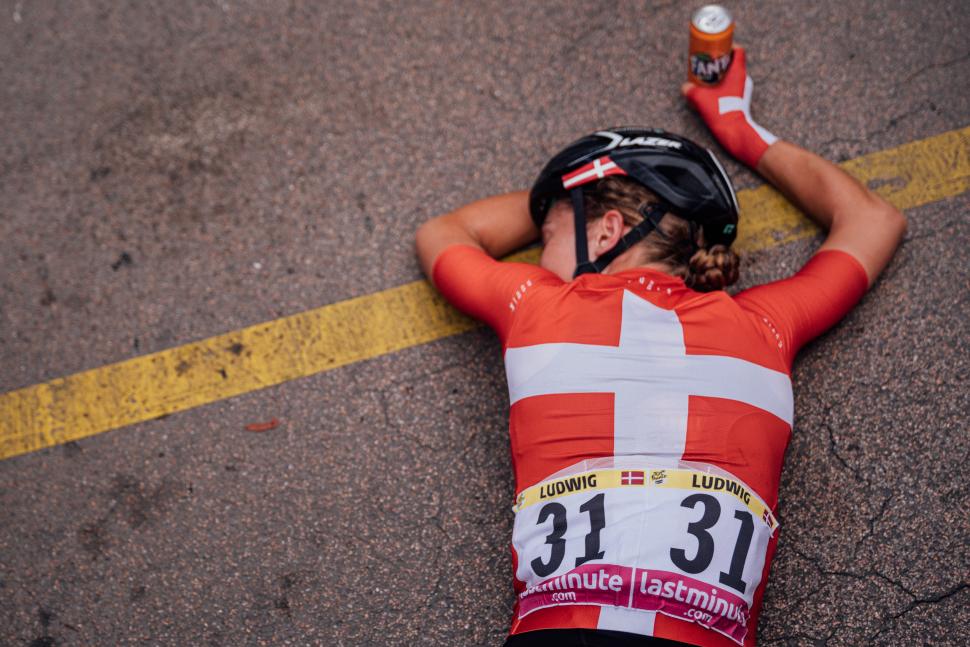
And, it’s safe to say, the women’s peloton certainly made the most of the opportunity during a frenetic, exhilarating week on the fan-packed roads of France last year.
Stage four’s foray onto gravel brought drama and chaos, while Cecilie Uttrup Ludwig’s brilliant, come-from-behind sprint in Épernay – after a torrid opening few days for the Dane’s FDJ-Suez-Futuroscope team – reinforced her position as one of the sport’s darlings and its most entertaining interviewee.
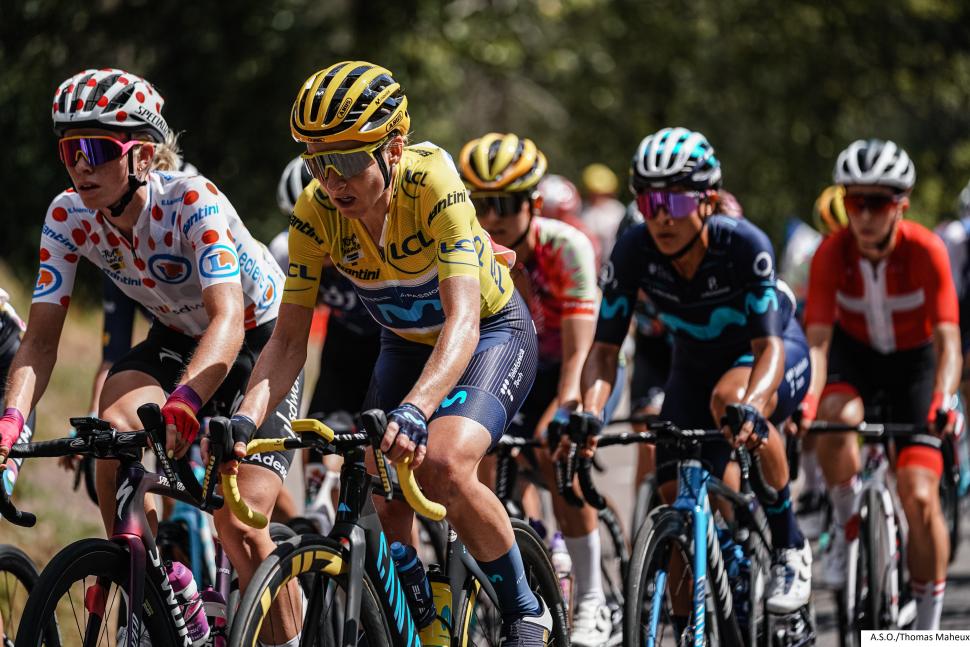
Meanwhile, Annemiek van Vleuten’s stunning success in the Vosges mountains, after a battle with illness earlier in the week, provided the race with an inspiring, if ultimately predictable, climax.
But it was the success of the greatest rider of all time, Marianne Vos, that perfectly encapsulated what was a week-long celebration of women’s cycling. Vos’s two stage wins and five days in the yellow jersey proved not only fitting for a rider who has given the sport so much during her long, storied career, but for women’s cycling itself.
This was a case of cycling’s most iconic rider finally gracing the stage she has deserved for almost two decades. Vos fought long and hard for her moment at the Tour, and she deserved every second of it.
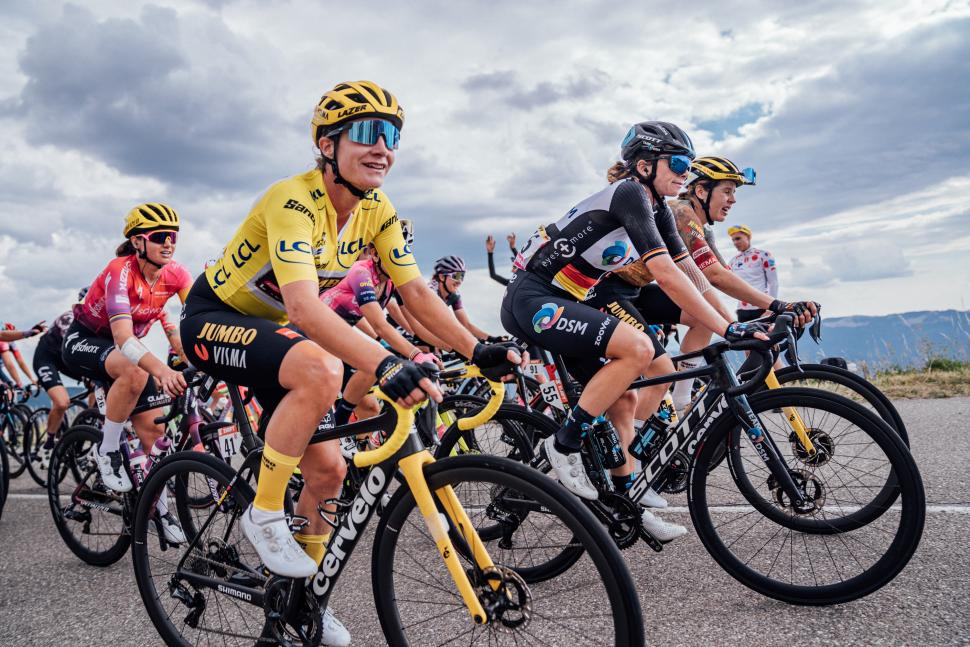
For one of the riders who took part in last year’s relaunched race, British road race champion Pfeiffer Georgi, the 2022 Tour de France Femmes was a “massive moment” for women’s cycling.
“It was a really amazing atmosphere,” the DSM rider told the road.cc Podcast . “We started on the Champs-Élysées and had our team presentation in front of the Eiffel Tower. The crowds were insane.
“Everyone had this feeling that it was a massive moment for women’s cycling. We waited a long time to have the race back, and just the support and the excitement of the racing every day, there was so much to fight for. And I felt very lucky to compete in the first edition of this new format.”
Of course, while we all got carried away with the euphoria of a fourth week of racing in July, the Tour Femmes isn’t perfect, and we should be cautious when evaluating what essentially amounts to a spot of late-stage band wagoning by ASO.
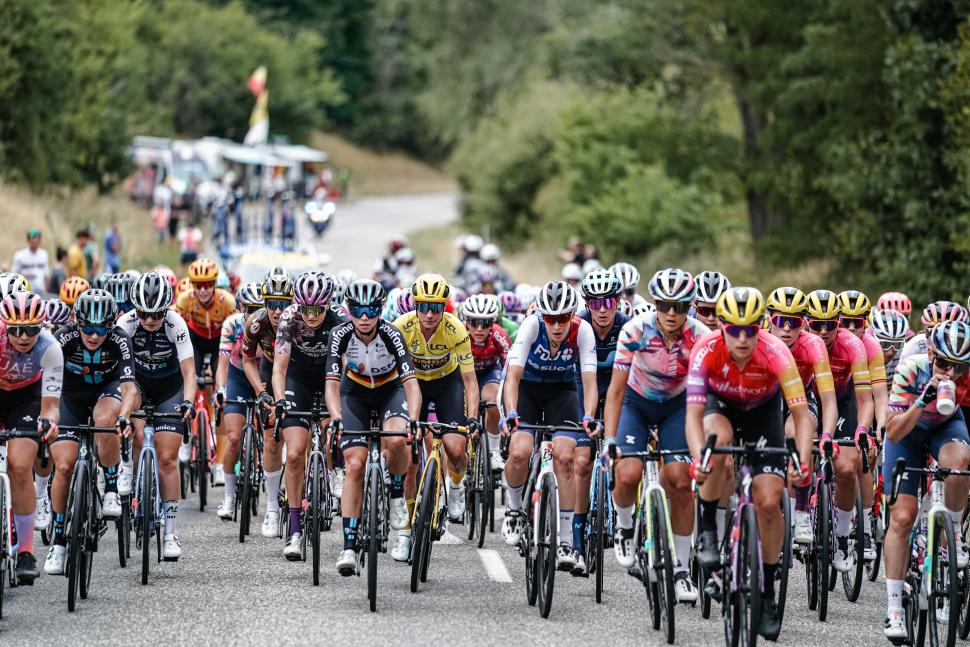
First, inequality still strikes at the heart of the relaunched women’s Tour. For starters, can an eight-day race really be defined as a ‘grand tour’? And even if there are plans in place to eventually expand the race to two, or even three, weeks, money remains an ever-present issue: Van Vleuten received €50,000 in prize money for her career-defining triumph, a tenth of what her male equivalent Jonas Vingegaard earned for winning the men’s Tour.
Despite the efforts of other race organisers, such as Flanders Classics – who this year began to offer equal prize money across its stable of one-day races – that chasm remains painfully intact for this year’s Tours de France.
Another measure of the gulf between how ASO views its male and female events lies most glaringly in the lack of line-to-line television coverage for the Tour Femmes. While the Tour Hommes has been graced with ‘every kilometre counts’ coverage for well over a decade now, the Tour Femmes more closely resembles the mid-2000s approach to watching a bike race on TV.
Last year, arguably the defining moment of the entire race came when Van Vleuten blew the field to shreds on the Petit Ballon, the first of stage seven’s three mammoth climbs – it’s just a shame no-one was able to see it, as the television cameras had yet to start rolling.

“I would love to see more TV coverage,” says Georgi. “I think that’s one of the most important things at the moment. People find our racing exciting, they want to watch it, and when it’s there, they do watch it. Some of the women’s classics have more viewers than the men’s.
“The interest and excitement are there, that’s where it all begins. That’s where people see it, that’s where sponsors get their products and name shown. TV coverage is the catalyst for everything, and getting our racing and love for the sport out there more.”
Reflecting on the impact of the Tour Femmes on women’s cycling, the 22-year-old continued: “The Tour is the pinnacle of cycling. And people who don’t know cycling always ask ‘have you raced it?’ I think everyone is so happy to say yes, we finally have it on our calendar.
“The first edition was eight stages, and I can see that growing over the years. It’s nice that it’s after the men’s Tour too, so the focus is on us. The crowds that came out, not just in Paris, but La Planche des Belles Filles was one of the craziest experiences I’ve had.
“It felt like I was on the Tour I’ve always watched on TV.”
It’s clear that women’s cycling, which experienced a great leap forward in terms of the quality of its races and the levels of professionalisation in the period between the last Grande Boucle in 2009 and the ‘inaugural’ Tour Femmes in 2022, deserves it place on cycling’s biggest stage.
It’s now up to ASO to make sure that the curtain doesn’t fall again.
Help us to fund our site
We’ve noticed you’re using an ad blocker. If you like road.cc, but you don’t like ads, please consider subscribing to the site to support us directly. As a subscriber you can read road.cc ad-free, from as little as £1.99.
If you don’t want to subscribe, please turn your ad blocker off. The revenue from adverts helps to fund our site.
Help us to bring you the best cycling content
If you’ve enjoyed this article, then please consider subscribing to road.cc from as little as £1.99. Our mission is to bring you all the news that’s relevant to you as a cyclist, independent reviews, impartial buying advice and more. Your subscription will help us to do more.
Ryan joined road.cc in December 2021 and since then has kept the site’s readers and listeners informed and enthralled (well at least occasionally) on news, the live blog, and the road.cc Podcast. After boarding a wrong bus at the world championships and ruining a good pair of jeans at the cyclocross, he now serves as road.cc’s senior news writer. Before his foray into cycling journalism, he wallowed in the equally pitiless world of academia, where he wrote a book about Victorian politics and droned on about cycling and bikes to classes of bored students (while taking every chance he could get to talk about cycling in print or on the radio). He can be found riding his bike very slowly around the narrow, scenic country lanes of Co. Down.
Add new comment
Latest comments.
It's hard to get banned. Take a look at a dash cam compilation, what happens to all those drivers? Nothing. What happened to the driver who lost...
Driver is guilty, therefore report. Admittedly, I am reporting to the unremittingly evil and anti-cyclist Lancashire Constabulary so my reports are...
These bureaucratic red-tape impediments to a dynamic economy have indeed been abolished in Lancashire, owing to the entirely Tory Constabulary...
That's how many people thought about doing business with Russia until not that long ago....
"Announcing this latest wave of funding"...
I see what you did there
They won't be rehiring anyone. They are just labels. It's all PR BS.
I think it's a bit hyperbole to say he lashed out or are you happy with msm sensationalist headlines?
Most likely since Thatcher in the 1980s...
It's left over right, then make a bunny ear and the second bunny pops out of the hole......
991km, 1 yellow jersey and $10,000 in debt: the incredible journey of one cyclist's historic Tour de France win
Marianne Martin's 1984 Tour de France was a world apart from today's Tour de France Femmes
- Sign up to our newsletter Newsletter
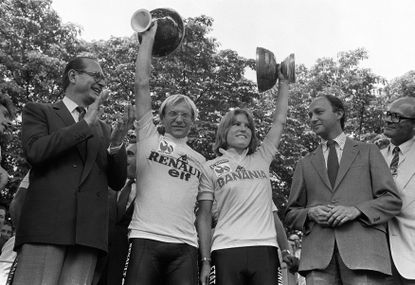
Today, thousands of cycling fans across the world flipped on their TVs to tune in as a 154-rider peloton made its way from Collonges-La-Rouge in the center of France west to Montignac-Lascaux for the third stage of the Tour de France Femmes avec Zwift. The quest for the iconic Maillot Jaune has gripped fans for more than three weeks already and it's not ever yet. The men's peloton has had its battle and now, the women take over to fight theirs. It almost feels like a given; the newness of a women's Tour de France already worn off after its momentous rebirth in 2022 .
But it's a race that was hard-fought for and one, that for the entirety of current yellow-jersey wearer Lotte Kopecky 's life, didn't even exist. Should she manage to keep the leader's jersey through the end of the race, she will be the second winner in a span of 34 years, and only the eight name on the women’s Tour de France winner’s list — as opposed to 110 on the men's side.
This void in the history books is one the first generation of women's Tour de France riders felt deeply. Today's well-funded, heavily marketed and professional operation that is the Tour de France Femmes and its contestants is also a far cry from the early days when riders were expected to fail and 1984 winner Marianne Martin went thousands of dollars in debt for a chance to compete.
"I think [the 1984 Tour de France Féminin] was a little bit before its time, but lucky for me. It shouldn't have been before its time; the attitude about women's sports should not have been any less than it is now, but realistically human nature changes slowly,” Martin told Cycling Weekly.
Martin was part of what many consider to be the heyday of women’s cycling: the 1980s.
These were the days of the iconic Coors Classic, which defined the careers of notable names like Connie Carpenter, Marie Canins, Jeannie Longo, Rebecca Twigg and Inga Thompson —the women that paved the way for icons like Leontien van Moorsel who in turn inspired the generation of Marianne Vos , Annemiek van Vleuten and Lizzie Deignan .
It was also the decade that saw the introduction of a women’s road race at the 1984 Olympics in Los Angeles, won by American multi-discipline Olympian Connie Carpenter.
Get The Leadout Newsletter
The latest race content, interviews, features, reviews and expert buying guides, direct to your inbox!
And that same year, the Société du Tour de France hosted the first official women’s Tour de France, held in conjunction with the men’s event.
At this event, the women raced 18 stages over 22 days, on the same day and on the same courses (albeit shorter) as the men — 991 km (616 miles) in pursuit of yellow.
“I loved that we did 18 days. We didn't have huge mileage, but we did have the big climbs,” Martin said.
Martin’s 1984 season had been a rocky one. Struggling with health problems, she’d been riding poorly, but managed to recover just in time to make the U.S. national selection for the Tour de France. At the time, the Tour de France Féminin was contested by national teams rather than the trade teams they have today. The peloton was also significantly smaller. Martin was part of a six-member squad that competed against six other national teams, including two teams from the host nation, Great Britain, the Netherlands and Canada —just 36 riders as opposed to today’s field of 144.
In the Tour then as well as today, the race was dominated by the Dutch. They won all but three stages, and Martin had to wait 12 days for her turn to shine. The Coloradan had come to France eyeing the polka dot jersey. And sure enough, on the first day in the Alps, the then-26-year-old was first across the finish line in Grenoble, taking the lead in the Queen of the Mountain classification along the way. Two days later, as the mountain stages continued, no one could match Martin’s climbing prowess as rode herself into overall lead as well. She held onto the Maillot Jaune all the way through the final stage on the Champs Élysées in Paris, finishing three minutes and 17 seconds ahead of Dutchwoman Heleen Hage.
The streets were filled with millions of people, newspaper records say. People who had gone through quite a journey themselves, Martin revealed.
“The French did not think we would finish 18 days of racing, and they were out there expecting us to fail,” Martin said.
But as the days went on, only those who crashed out or got sick abandoned the Tour, just like in the men’s event. The rest plowed on though the French countryside and over the mountains. By the time the peloton reached Paris, the road side spectators were fans in earnest.
Eight Days is Not Enough
The crowds are massive at this year’s Tour de France Femmes avec Zwift as well, both along the roads in person and following along virtually.
"We as female athletes have long proven that we're capable,” Martin said. “I feel that there's much more long-term committed support behind the women's race now than there was then."
Martin did critique the women’s Tour de France revival for being too short.
“We did 18 stages and finished about two hours before the men came in. I loved how that was done. [With this year’s Tour de France Femmes] I personally would've liked to have seen the women do the same stages at the same time as the men then versus doing it in reverse and only eight days,” Martin commented.
"There's something about exceeding the expected that puts you against yourself in a way that doesn't happen when it's not quite so pushed.
“One day when we had a rest day, it was probably after eight or 10 days of racing, I really don't know what day it was, but there was a cute little courtyard down below my window so I'm like, ‘I'm gonna go walk downstairs and sit in the courtyard’. I could not even sit in the courtyard. I had to go back upstairs and lay down. I was completely wasted, but then you go out and race the next day and well, I won the next day and it’s amazing what your body can do.”
Having a women’s Tour de France or Paris-Roubaix or Milan-San Remo has never been about women lacking the skill or ability, Martin argued. It’s about women being allowed to compete and having the resources to do so.
“I know there's a lot of different factors going on, but I think women are much more capable than men can begin to think,” she said. “I do believe it needs to be a business decision to add women’s events. It's got to make money in the end, and thank God Zwift came in and is supporting it .”
$10,000 in debt
When Martin grabbed her opportunity to race the Tour de France in 1984, she did so at great expense, both financially and physically.
“To get a place on the U.S. cycling team, you had to do certain races, and they were all around the country. I had a local team that would pay my entry fee [at local event] but they had no benefit for me to win a race in California, or even be in a race in California because they were a local company,” she stated.
And so, the travel expenses came out of her own pocket.
“I just put it on my credit card, because I wanted to go to the top. I wasn't going to let money stop me from doing what I really wanted to do in my life, because I knew I had my whole life to repay money. It was my body that was limited,” she said.
She went $10,000 in debt to pursue her dream, which in today’s economy is closer to $30,000 — a rather significant chunk of change.
Following her Tour de France success, Martin hoped to find sponsors and fund a team to continue racing, but the money wasn’t there and the debt kept growing. And then her body gave in.
“The year after the Tour I got selected to go race the spring series in Europe, which was great. It's just that it rained pretty much every day, and I got sick but kept racing, because, you know, you just do. But I came back from that and that's when my body started really having trouble. Like I just couldn't recover,” she said.
She kept at it, racing big events like the Coors Classic despite her body showing clear signs that it was unable to keep up.
“I tore my body down more and more, and I really struggled that year. The next year wasn't any better. I wasn't racing well, I wasn't healthy. And so I made the decision to quit,” she recalled.
In financial and physical trouble, Martin moved to Los Angeles, California to take an advertising job. She lived in the City of Angels for two years, two months and 14 days —an exact number she rattled off as though that’s a completely normal thing people do. When asked why she counted the days there, Martin explained that as a small town Colorado woman, the big city was entirely overwhelming. It also broke her heart to not be racing, but her health problems persevered.
“I paid off all my debt in those two years, but I didn't really ride much for 20 years. My body wasn't recovering, and if I went aerobic, I would end up getting sick,” she shared.
Eventually, the Colorado mountain air and an air purifier inside her house showed improvements in her health.
“It completely changed my life. I don't really know what [the illness] was and you know what, I don't care at all, because I got my life back. I started trail running and cycling again, and now it's still part of my life,” she said.
A post shared by Kate ‘BFK’ Veronneau (@kateveronneau) A photo posted by on
Post-Tour Life
These days, Martin enjoys a quiet life as a portrait photographer, and lost touch with the cycling world many years ago. It was only the creation of the Tour de France Femmes and all the hype around it that threw her back in.
“I've been doing more interviews and stuff now than I ever did when my race was on,” she commented. “I don't even have a TV and don’t follow cycling much. Sometimes when the Tour is on, I'll go work at a coffee shop so I can watch it. I do still love hearing Phil Liggett’s voice.”
When asked what she remembers most fondly of her racing days, Martin said simply, “adrenaline.”
“I do love adrenaline. I'm a complete adrenaline junkie and I'm a real fitness junkie, too. At that time in my life, I got my fix of adrenaline every week and I traveled with the best people, the best friends, all around the country for the U.S. circuit. I loved my life. It was very exciting and very emotional. There were definite ups and downs, but it was intense. I love intensity. It was everything I could ask for,” she said.
“It was hard to transition away from it, but now cycling to me is a social way of fitness.”
Thank you for reading 20 articles this month* Join now for unlimited access
Enjoy your first month for just £1 / $1 / €1
*Read 5 free articles per month without a subscription
Join now for unlimited access
Try first month for just £1 / $1 / €1
Cycling Weekly 's North American Editor, Anne-Marije Rook is old school. She holds a degree in journalism and started out as a newspaper reporter — in print! She can even be seen bringing a pen and notepad to the press conference.
Originally from The Netherlands, she grew up a bike commuter and didn't find bike racing until her early twenties when living in Seattle, Washington. Strengthened by the many miles spent darting around Seattle's hilly streets on a steel single speed, Rook's progression in the sport was a quick one. As she competed at the elite level, her journalism career followed, and soon she became a full-time cycling journalist. She's now been a cycling journalist for 11 years.
The Briton has finished eighth and ninth at the Giro d'Italia since his Vuelta podium
By Chris Marshall-Bell Published 23 March 24
Fitness gadgets use very emotive language, but should we be allowing them to press our buttons? Dr Josephine Perry investigates
By Josephine Perry Published 23 March 24
Belgian aiming to peak in April with Paris-Roubaix a potential target
By Tom Thewlis Published 23 January 24
With so much packed into the route, is it too rich a meal?
By Adam Becket Published 31 October 23
Mathieu van der Poel and Lotte Kopecky named as best Classics riders at French awards ceremony
By Adam Becket Published 25 October 23
A Giro di Lombardia live stream is the best way to keep up with this year's race. Here's how to watch in 2023.
By Cycling Weekly Published 7 October 23
The flying Dutchwoman could almost win it all, but now her era has almost ended, she should be remembered as the greatest
By Adam Becket Published 31 July 23
SD Worx rider seals yellow jersey with three-minute gap, as team-mate Marlen Reusser triumphs on stage eight
By Tom Davidson Published 30 July 23
Reigning champion concedes defeat to compatriot on Col du Tourmalet
By Tom Davidson Published 29 July 23
Dutchwoman lays waste to GC rivals on stage seven and takes the yellow jersey
Useful links
- Tour de France
- Giro d'Italia
- Vuelta a España
Buyer's Guides
- Best road bikes
- Best gravel bikes
- Best smart turbo trainers
- Best cycling computers
- Editor's Choice
- Bike Reviews
- Component Reviews
- Clothing Reviews
- Contact Future's experts
- Terms and conditions
- Privacy policy
- Cookies policy
- Advertise with us
Cycling Weekly is part of Future plc, an international media group and leading digital publisher. Visit our corporate site . © Future Publishing Limited Quay House, The Ambury, Bath BA1 1UA. All rights reserved. England and Wales company registration number 2008885.
- >", "name": "top-nav-watch", "type": "link"}}' href="https://watch.outsideonline.com">Watch
- >", "name": "top-nav-learn", "type": "link"}}' href="https://learn.outsideonline.com">Learn
- >", "name": "top-nav-podcasts", "type": "link"}}' href="https://www.outsideonline.com/podcast-directory/">Podcasts
- >", "name": "top-nav-maps", "type": "link"}}' href="https://www.gaiagps.com">Maps
- >", "name": "top-nav-events", "type": "link"}}' href="https://www.athletereg.com/events">Events
- >", "name": "top-nav-shop", "type": "link"}}' href="https://shop.outsideonline.com">Shop
- >", "name": "top-nav-buysell", "type": "link"}}' href="https://www.pinkbike.com/buysell">BuySell
- >", "name": "top-nav-outside", "type": "link"}}' href="https://www.outsideonline.com/outsideplus">Outside+
Become a Member
Get access to more than 30 brands, premium video, exclusive content, events, mapping, and more.
Already have an account? >", "name": "mega-signin", "type": "link"}}' class="u-color--red-dark u-font--xs u-text-transform--upper u-font-weight--bold">Sign In
Outside watch, outside learn.
- >", "name": "mega-backpacker-link", "type": "link"}}' href="https://www.backpacker.com/">Backpacker
- >", "name": "mega-climbing-link", "type": "link"}}' href="https://www.climbing.com/">Climbing
- >", "name": "mega-flyfilmtour-link", "type": "link"}}' href="https://flyfilmtour.com/">Fly Fishing Film Tour
- >", "name": "mega-gaiagps-link", "type": "link"}}' href="https://www.gaiagps.com/">Gaia GPS
- >", "name": "mega-npt-link", "type": "link"}}' href="https://www.nationalparktrips.com/">National Park Trips
- >", "name": "mega-outsideonline-link", "type": "link"}}' href="https://www.outsideonline.com/">Outside
- >", "name": "mega-outsideio-link", "type": "link"}}' href="https://www.outside.io/">Outside.io
- >", "name": "mega-outsidetv-link", "type": "link"}}' href="https://watch.outsideonline.com">Outside Watch
- >", "name": "mega-ski-link", "type": "link"}}' href="https://www.skimag.com/">Ski
- >", "name": "mega-warrenmiller-link", "type": "link"}}' href="https://warrenmiller.com/">Warren Miller Entertainment
Healthy Living
- >", "name": "mega-ce-link", "type": "link"}}' href="https://www.cleaneatingmag.com/">Clean Eating
- >", "name": "mega-oxy-link", "type": "link"}}' href="https://www.oxygenmag.com/">Oxygen
- >", "name": "mega-vt-link", "type": "link"}}' href="https://www.vegetariantimes.com/">Vegetarian Times
- >", "name": "mega-yj-link", "type": "link"}}' href="https://www.yogajournal.com/">Yoga Journal
- >", "name": "mega-beta-link", "type": "link"}}' href="https://www.betamtb.com/">Beta
- >", "name": "mega-pinkbike-link", "type": "link"}}' href="https://www.pinkbike.com/">Pinkbike
- >", "name": "mega-roll-link", "type": "link"}}' href="https://www.rollmassif.com/">Roll Massif
- >", "name": "mega-trailforks-link", "type": "link"}}' href="https://www.trailforks.com/">Trailforks
- >", "name": "mega-trail-link", "type": "link"}}' href="https://trailrunnermag.com/">Trail Runner
- >", "name": "mega-tri-link", "type": "link"}}' href="https://www.triathlete.com/">Triathlete
- >", "name": "mega-vn-link", "type": "link"}}' href="https://velo.outsideonline.com/">Velo
- >", "name": "mega-wr-link", "type": "link"}}' href="https://www.womensrunning.com/">Women's Running
- >", "name": "mega-athletereg-link", "type": "link"}}' href="https://www.athletereg.com/">athleteReg
- >", "name": "mega-bicycleretailer-link", "type": "link"}}' href="https://www.bicycleretailer.com/">Bicycle Retailer & Industry News
- >", "name": "mega-cairn-link", "type": "link"}}' href="https://www.getcairn.com/">Cairn
- >", "name": "mega-finisherpix-link", "type": "link"}}' href="https://www.finisherpix.com/">FinisherPix
- >", "name": "mega-idea-link", "type": "link"}}' href="https://www.ideafit.com/">Idea
- >", "name": "mega-nastar-link", "type": "link"}}' href="https://www.nastar.com/">NASTAR
- >", "name": "mega-shop-link", "type": "link"}}' href="https://www.outsideinc.com/outside-books/">Outside Books
- >", "name": "mega-veloswap-link", "type": "link"}}' href="https://www.veloswap.com/">VeloSwap
- >", "name": "mega-backpacker-link-accordion", "type": "link"}}' href="https://www.backpacker.com/">Backpacker
- >", "name": "mega-climbing-link-accordion", "type": "link"}}' href="https://www.climbing.com/">Climbing
- >", "name": "mega-flyfilmtour-link-accordion", "type": "link"}}' href="https://flyfilmtour.com/">Fly Fishing Film Tour
- >", "name": "mega-gaiagps-link-accordion", "type": "link"}}' href="https://www.gaiagps.com/">Gaia GPS
- >", "name": "mega-npt-link-accordion", "type": "link"}}' href="https://www.nationalparktrips.com/">National Park Trips
- >", "name": "mega-outsideonline-link-accordion", "type": "link"}}' href="https://www.outsideonline.com/">Outside
- >", "name": "mega-outsidetv-link-accordion", "type": "link"}}' href="https://watch.outsideonline.com">Watch
- >", "name": "mega-ski-link-accordion", "type": "link"}}' href="https://www.skimag.com/">Ski
- >", "name": "mega-warrenmiller-link-accordion", "type": "link"}}' href="https://warrenmiller.com/">Warren Miller Entertainment
- >", "name": "mega-ce-link-accordion", "type": "link"}}' href="https://www.cleaneatingmag.com/">Clean Eating
- >", "name": "mega-oxy-link-accordion", "type": "link"}}' href="https://www.oxygenmag.com/">Oxygen
- >", "name": "mega-vt-link-accordion", "type": "link"}}' href="https://www.vegetariantimes.com/">Vegetarian Times
- >", "name": "mega-yj-link-accordion", "type": "link"}}' href="https://www.yogajournal.com/">Yoga Journal
- >", "name": "mega-beta-link-accordion", "type": "link"}}' href="https://www.betamtb.com/">Beta
- >", "name": "mega-roll-link-accordion", "type": "link"}}' href="https://www.rollmassif.com/">Roll Massif
- >", "name": "mega-trail-link-accordion", "type": "link"}}' href="https://trailrunnermag.com/">Trail Runner
- >", "name": "mega-tri-link-accordion", "type": "link"}}' href="https://www.triathlete.com/">Triathlete
- >", "name": "mega-vn-link-accordion", "type": "link"}}' href="https://velo.outsideonline.com/">Velo
- >", "name": "mega-wr-link-accordion", "type": "link"}}' href="https://www.womensrunning.com/">Women's Running
- >", "name": "mega-athletereg-link-accordion", "type": "link"}}' href="https://www.athletereg.com/">athleteReg
- >", "name": "mega-bicycleretailer-link-accordion", "type": "link"}}' href="https://www.bicycleretailer.com/">Bicycle Retailer & Industry News
- >", "name": "mega-finisherpix-link-accordion", "type": "link"}}' href="https://www.finisherpix.com/">FinisherPix
- >", "name": "mega-idea-link-accordion", "type": "link"}}' href="https://www.ideafit.com/">Idea
- >", "name": "mega-nastar-link-accordion", "type": "link"}}' href="https://www.nastar.com/">NASTAR
- >", "name": "mega-shop-link-accordion", "type": "link"}}' href="https://shop.outsideonline.com/">Outside Shop
- >", "name": "mega-vp-link-accordion", "type": "link"}}' href="https://www.velopress.com/">VeloPress
- >", "name": "mega-veloswap-link-accordion", "type": "link"}}' href="https://www.veloswap.com/">VeloSwap
2-FOR-1 GA TICKETS WITH OUTSIDE+
Don’t miss Thundercat, Fleet Foxes, and more at the Outside Festival.
GET TICKETS
OUTSIDE FESTIVAL JUNE 1-2
Don't miss Thundercat + Fleet Foxes, adventure films, experiences, and more!
A brief history of the ‘women’s Tour de France’
This year's big dance isn't the first time women have stage raced across france, but organizers and sponsors say this time it will stick..
Heading out the door? Read this article on the new Outside+ app available now on iOS devices for members! >","name":"in-content-cta","type":"link"}}'>Download the app .
Much ado is being made about this year’s ‘inaugural’ Tour de France Femmes avec Zwift , but it’s not entirely fair to call it the first Tour de France for women.
Yes, this Tour is the first women’s stage race in France produced by the modern-day Amaury Sport Organization (ASO), the organizer of the men’s race. However, other promoters have tried — and regrettably, failed — to bring an equivalent French stage race to the women’s peloton for over half a century.
Let’s take a look.
“1955”
The first attempt at TdF equivalency for the women’s peloton happened in 1955, when French sports journalist Jean Leulliot launched the first ‘women’s Tour.’ Leulliot, who became notable for directing Paris-Nice for 25 years, hoped for seven stages of 80-100km apiece but had to settle for five.
At the time, there was no women’s road world championships, and the French Cycling Federation had only held four national championship races for women.
This historical precedent did not bode well for Leulliot’s race — although 41 women lined up (with Manx cyclist Millie Robinson winning), the race was a one-off, with no successor until the 80s.
1984–1989: Tour de France Féminin
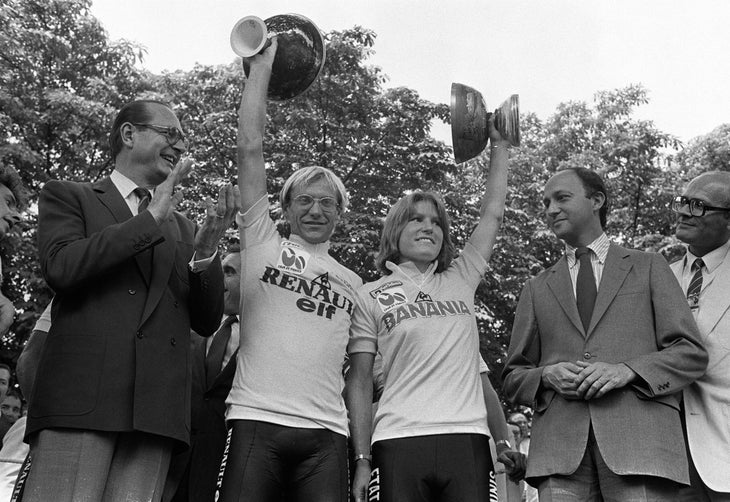
In 1984, the Société du Tour de France, the then-organizer of the men’s Tour de France, introduced a women’s version of the Tour. For six years, the Tour de France Féminin was run alongside the men’s event, as a sort of curtain raiser.
The women’s race featured shorter distances, with both races using the same stage finish locations. The first edition had 18 stages, but dwindled to 11 by its final year in 1989.
American Marianne Martin won the first edition of the race in 1984, Italian Maria Canins won the second and third, and French phenom Jeannie Longo won the final three races.
In 1989, Jean-Marie Leblanc, the director of the Tour de France, halted the race in its current format, citing — wait for it — the economic cost of organizing the race with limited media coverage and sponsorship.
1990–1993: Tour of the EEC Women/ Tour de la C.E.E. féminin
Without the backing of the Société du Tour de France, other people stepped in to try and keep a ‘women’s Tour’ alive. The Tour of the EEC Women ran from 1990-1993. This race ranged from nine to 12 stages long and was first won by four-time world champion Frenchwoman Catherine Marsal.
Not much is written in the history books about these years of the race, perhaps because the Société du Tour de France — which became part of the ASO in 1992 — chose not to acknowledge it.
1992–2009: The Pierre Boué races: Tour Cycliste Féminin (1992–1997) and Grande Boucle Féminine Internationale (1998–2009)
In 1992, another French journalist, Pierre Boué, launched the Tour Cycliste Féminin to fill the void left by the axed women’s Tour de France.
While the race ran with moderate success for over a decade and a half, it often lacked stable sponsorship and suffered chronically from issues like poor accommodations, unnecessarily long neutral starts, and unpaid prize money. Boué had trouble finding towns willing to host stages, which led to long transfers and an inconsistent number of stages over the years.
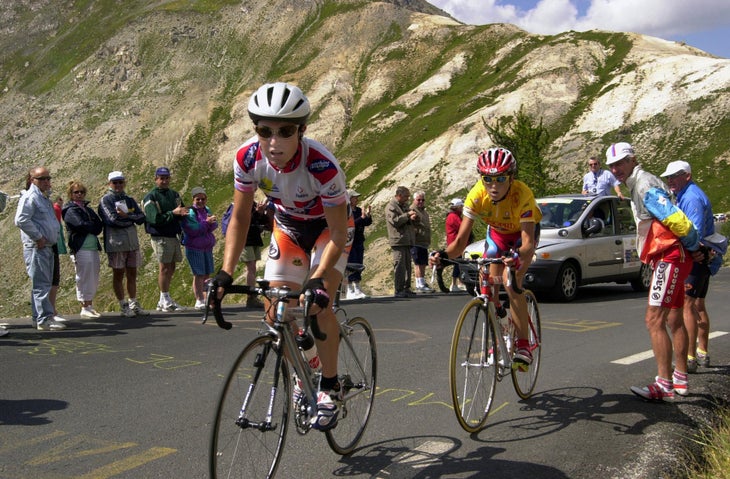
Then, before the 1998 edition, the ASO claimed that the name of the race — Tour Cycliste Féminin — was a trademark infringement. From 1998 forward, the race became known as the Grande Boucle Féminine Internationale.
For the first 12 years of this stage race, women raced an average of 13 or 14 stages. Then, after a hiatus in 2004, it returned with a smaller size and scope. Only 66 riders lined up for the race’s final edition in 2009 — after a planned race start and three stages in Britain fell through, the race was only four days long.
The Grande Boucle ended after that year, citing insurmountable financial hardship due to lack of sponsorship, interest, and media coverage.
Other races
There were other stage races in France, like the Tour de l’Aude Cycliste Féminin (1985-2010) and the Route de France Féminine (2006-2015), that were successful for a period of time but that ultimately succumbed to the same old issues: financial and organizational dysfunction. Without a direct relationship to the ASO/Tour de France, it seemed that all races were doomed to fail at some point.
One light in that dark period has been the Tour Cycliste Féminin International de l’Ardèche , a weeklong stage race that has been held in southeastern France since 2003.

2014-2020: La Course
In 2014, professional cyclists Emma Pooley, Kathryn Bertine, and Marianne Vos, along with Ironman triathlete Chrissie Wellington, submitted a petition to Christian Prudhomme, the director of the Tour de France, demanding that women be allowed to race. The ASO responded by launching La Course by Le Tour de France.
The inaugural event was held as a one-day circuit race on the Champs-Élysées on the final day of the 2014 Tour de France. Subsequent editions were also short and sprinter-friendly.
In 2017, race organizers experimented with a two-day event: day one ended with a summit finish on the Col d’Izoard on the same day as stage 18 of the men’s race. It was followed by a time trial in Marseille. Annemiek van Vleuten won both stages and the overall title.
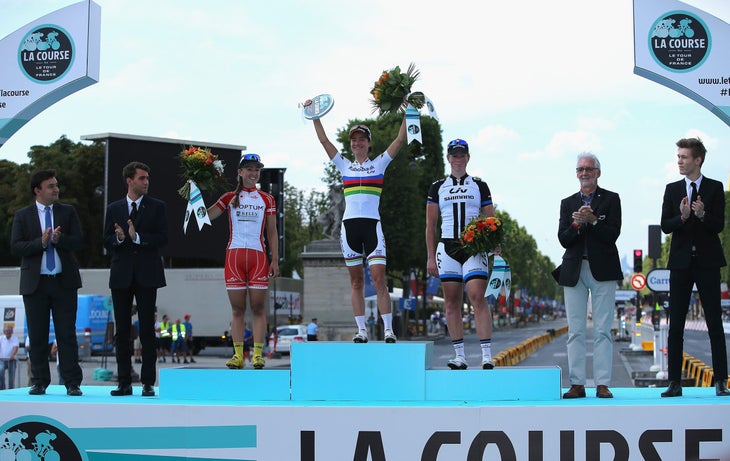
In 2018, the race shrunk back to one day and remained that way for its final editions in 2019 and 2020.
Initially praised for the exposure gained by ‘sharing the stage’ with the Tour de France, La Course was equally criticized for its brevity — both in duration and the distances of the parcours.
The ASO was also criticized for not doing enough to promote the race. The organization repeatedly stated that it would be logistically impossible to stage a women’s stage race at the same time as the men’s.
2022: Tour de France Femmes avec Zwift
After over 30 years and half as many excuses, the ASO is putting on a women’s Tour de France. Zwift has signed on as a four-year title sponsor, and the race has its own eight days on the calendar — beginning with a stage on the Champs-Élysées on July 24 before the men roll into Paris on the last day of their race.
When the route was revealed in October of last year, riders were mostly pleased with the parcours. A few VeloNews editors also agreed: eight days seemed like a promising start given the current situation of the women’s peloton (ie. its depth and resources, not the riders’ ability to race a longer event).
24 teams will ride 1,029 kilometers over the eight stages, and the race ends with a summit finish atop the Super Planche des Belles Filles.
Long the bane of women’s pro racing, TV broadcasting of the TdFF is locked and loaded. NBC Sports has rights to broadcast the race in the U.S. in both 2022 and 2023, and Europeans can watch on Discovery Sports and Eurovision Sport. ESPN will broadcast in Latin America and the Caribbean, and Australians can watch the action on SBS OnDemand.
Popular on Velo
\n >\", \"path\": \"https:\/\/velo.outsideonline.com\/news\/cyclist-fighting-for-his-life-after-contracting-flesh-eating-disease-from-saddle-sore\/\", \"listing_type\": \"recirc\", \"location\": \"list\", \"title\": \"cyclist fighting for his life after contracting flesh-eating disease from saddle sore\"}}\u0027>\n cyclist fighting for his life after contracting flesh-eating disease from saddle sore\n \n \n \n \n \n\n \n \n \n \n \n\n \n "},{"title":"think gravel cycling is a recent phenomenon a 60-year-old frame says otherwise.","url":"https:\/\/velo.outsideonline.com\/gravel\/gravel-culture\/first-gravel-bike-john-finley-scott-cow-trailing\/","markup":" \n \n\n\n \n\n \n \n >\", \"path\": \"https:\/\/velo.outsideonline.com\/gravel\/gravel-culture\/first-gravel-bike-john-finley-scott-cow-trailing\/\", \"listing_type\": \"recirc\", \"location\": \"list\", \"title\": \"think gravel cycling is a recent phenomenon a 60-year-old frame says otherwise.\"}}\u0027>\n \n \n \n \n \n \n\n \n \n\n \n\n \n \n\n \n \n >\", \"path\": \"https:\/\/velo.outsideonline.com\/gravel\/gravel-culture\/first-gravel-bike-john-finley-scott-cow-trailing\/\", \"listing_type\": \"recirc\", \"location\": \"list\", \"title\": \"think gravel cycling is a recent phenomenon a 60-year-old frame says otherwise.\"}}\u0027>\n think gravel cycling is a recent phenomenon a 60-year-old frame says otherwise.\n \n \n \n \n \n\n \n \n \n \n \n\n \n "},{"title":"10 must see builds from the philly bike expo","url":"https:\/\/velo.outsideonline.com\/gravel\/gravel-gear\/10-must-see-builds-from-the-philly-bike-expo\/","markup":" \n \n\n\n \n\n \n \n >\", \"path\": \"https:\/\/velo.outsideonline.com\/gravel\/gravel-gear\/10-must-see-builds-from-the-philly-bike-expo\/\", \"listing_type\": \"recirc\", \"location\": \"list\", \"title\": \"10 must see builds from the philly bike expo\"}}\u0027>\n \n \n \n \n \n \n\n \n \n\n \n\n \n \n\n \n \n >\", \"path\": \"https:\/\/velo.outsideonline.com\/gravel\/gravel-gear\/10-must-see-builds-from-the-philly-bike-expo\/\", \"listing_type\": \"recirc\", \"location\": \"list\", \"title\": \"10 must see builds from the philly bike expo\"}}\u0027>\n 10 must see builds from the philly bike expo\n \n \n \n \n \n\n \n \n \n \n \n\n \n "},{"title":"tadej poga\u010dar buries everyone in avalanche of attacks at volta a catalunya","url":"https:\/\/velo.outsideonline.com\/road\/road-racing\/tadej-pogacar-buries-everyone-in-avalanche-of-attacks-at-volta-a-catalunya\/","markup":" \n \n\n\n \n\n \n \n >\", \"path\": \"https:\/\/velo.outsideonline.com\/road\/road-racing\/tadej-pogacar-buries-everyone-in-avalanche-of-attacks-at-volta-a-catalunya\/\", \"listing_type\": \"recirc\", \"location\": \"list\", \"title\": \"tadej poga\u010dar buries everyone in avalanche of attacks at volta a catalunya\"}}\u0027>\n \n \n \n \n \n \n\n \n \n\n \n\n \n \n\n \n \n >\", \"path\": \"https:\/\/velo.outsideonline.com\/road\/road-racing\/tadej-pogacar-buries-everyone-in-avalanche-of-attacks-at-volta-a-catalunya\/\", \"listing_type\": \"recirc\", \"location\": \"list\", \"title\": \"tadej poga\u010dar buries everyone in avalanche of attacks at volta a catalunya\"}}\u0027>\n tadej poga\u010dar buries everyone in avalanche of attacks at volta a catalunya\n \n \n \n \n \n\n \n \n \n \n \n\n \n "},{"title":"the 5 best road rides in the world","url":"https:\/\/velo.outsideonline.com\/road\/road-culture\/the-5-best-road-rides-in-the-world\/","markup":" \n \n\n\n \n\n \n \n >\", \"path\": \"https:\/\/velo.outsideonline.com\/road\/road-culture\/the-5-best-road-rides-in-the-world\/\", \"listing_type\": \"recirc\", \"location\": \"list\", \"title\": \"the 5 best road rides in the world\"}}\u0027>\n \n \n \n \n \n \n\n \n \n\n \n\n \n \n\n \n \n >\", \"path\": \"https:\/\/velo.outsideonline.com\/road\/road-culture\/the-5-best-road-rides-in-the-world\/\", \"listing_type\": \"recirc\", \"location\": \"list\", \"title\": \"the 5 best road rides in the world\"}}\u0027>\n the 5 best road rides in the world\n \n \n \n \n \n\n \n \n \n \n \n\n \n "},{"title":"wout van aert licks wounds post-e3 saxo classic","url":"https:\/\/velo.outsideonline.com\/road\/road-racing\/wout-van-aert-licks-wounds-post-e3-saxo-classic\/","markup":" \n \n\n\n \n\n \n \n >\", \"path\": \"https:\/\/velo.outsideonline.com\/road\/road-racing\/wout-van-aert-licks-wounds-post-e3-saxo-classic\/\", \"listing_type\": \"recirc\", \"location\": \"list\", \"title\": \"wout van aert licks wounds post-e3 saxo classic\"}}\u0027>\n \n \n \n \n \n \n\n \n \n\n \n\n \n \n\n \n \n >\", \"path\": \"https:\/\/velo.outsideonline.com\/road\/road-racing\/wout-van-aert-licks-wounds-post-e3-saxo-classic\/\", \"listing_type\": \"recirc\", \"location\": \"list\", \"title\": \"wout van aert licks wounds post-e3 saxo classic\"}}\u0027>\n wout van aert licks wounds post-e3 saxo classic\n \n \n \n \n \n\n \n \n \n \n \n\n \n "},{"title":"\u2018we stopped for a pee-pee and hid in the bushes\u2019: how tadej poga\u010dar destroyed everyone and set a new climbing record","url":"https:\/\/velo.outsideonline.com\/road\/road-racing\/we-stopped-for-a-pee-pee-and-hid-in-the-bushes-how-tadej-pogacar-destroyed-everyone-and-set-a-new-climbing-record\/","markup":" \n \n\n\n \n\n \n \n >\", \"path\": \"https:\/\/velo.outsideonline.com\/road\/road-racing\/we-stopped-for-a-pee-pee-and-hid-in-the-bushes-how-tadej-pogacar-destroyed-everyone-and-set-a-new-climbing-record\/\", \"listing_type\": \"recirc\", \"location\": \"list\", \"title\": \"\u2018we stopped for a pee-pee and hid in the bushes\u2019: how tadej poga\u010dar destroyed everyone and set a new climbing record\"}}\u0027>\n \n \n \n \n \n \n\n \n \n\n \n\n \n \n\n \n \n >\", \"path\": \"https:\/\/velo.outsideonline.com\/road\/road-racing\/we-stopped-for-a-pee-pee-and-hid-in-the-bushes-how-tadej-pogacar-destroyed-everyone-and-set-a-new-climbing-record\/\", \"listing_type\": \"recirc\", \"location\": \"list\", \"title\": \"\u2018we stopped for a pee-pee and hid in the bushes\u2019: how tadej poga\u010dar destroyed everyone and set a new climbing record\"}}\u0027>\n \u2018we stopped for a pee-pee and hid in the bushes\u2019: how tadej poga\u010dar destroyed everyone and set a new climbing record\n \n \n \n \n \n\n \n \n \n \n \n\n \n "},{"title":"will the van der poel-philipsen bromance survive alpecin-deceuninck\u2019s milan-san remo success","url":"https:\/\/velo.outsideonline.com\/road\/road-racing\/will-the-mathieu-van-der-poel-jasper-philipsen-bromance-survive\/","markup":" \n \n\n\n \n\n \n \n >\", \"path\": \"https:\/\/velo.outsideonline.com\/road\/road-racing\/will-the-mathieu-van-der-poel-jasper-philipsen-bromance-survive\/\", \"listing_type\": \"recirc\", \"location\": \"list\", \"title\": \"will the van der poel-philipsen bromance survive alpecin-deceuninck\u2019s milan-san remo success\"}}\u0027>\n \n \n \n \n \n \n\n \n \n\n \n\n \n \n\n \n \n >\", \"path\": \"https:\/\/velo.outsideonline.com\/road\/road-racing\/will-the-mathieu-van-der-poel-jasper-philipsen-bromance-survive\/\", \"listing_type\": \"recirc\", \"location\": \"list\", \"title\": \"will the van der poel-philipsen bromance survive alpecin-deceuninck\u2019s milan-san remo success\"}}\u0027>\n will the van der poel-philipsen bromance survive alpecin-deceuninck\u2019s milan-san remo success\n \n \n \n \n \n\n \n \n \n \n \n\n \n "},{"title":"\u2018three grand tours and no monument \u2013 it\u2019s like something\u2019s missing\u2019: wout van aert under spotlight in must-win spring","url":"https:\/\/velo.outsideonline.com\/road\/road-racing\/wout-van-aert-under-spotlight-in-must-win-spring\/","markup":" \n \n\n\n \n\n \n \n >\", \"path\": \"https:\/\/velo.outsideonline.com\/road\/road-racing\/wout-van-aert-under-spotlight-in-must-win-spring\/\", \"listing_type\": \"recirc\", \"location\": \"list\", \"title\": \"\u2018three grand tours and no monument \u2013 it\u2019s like something\u2019s missing\u2019: wout van aert under spotlight in must-win spring\"}}\u0027>\n \n \n \n \n \n \n\n \n \n\n \n\n \n \n\n \n \n >\", \"path\": \"https:\/\/velo.outsideonline.com\/road\/road-racing\/wout-van-aert-under-spotlight-in-must-win-spring\/\", \"listing_type\": \"recirc\", \"location\": \"list\", \"title\": \"\u2018three grand tours and no monument \u2013 it\u2019s like something\u2019s missing\u2019: wout van aert under spotlight in must-win spring\"}}\u0027>\n \u2018three grand tours and no monument \u2013 it\u2019s like something\u2019s missing\u2019: wout van aert under spotlight in must-win spring\n \n \n \n \n \n\n \n \n \n \n \n\n \n "},{"title":"meet the only person who can fix your brooks saddle (in north america, at least)","url":"https:\/\/velo.outsideonline.com\/road\/road-gear\/only-brooks-saddle-repair-north-america-simon-firth-philly-bike-expo\/","markup":" \n \n\n\n \n\n \n \n >\", \"path\": \"https:\/\/velo.outsideonline.com\/road\/road-gear\/only-brooks-saddle-repair-north-america-simon-firth-philly-bike-expo\/\", \"listing_type\": \"recirc\", \"location\": \"list\", \"title\": \"meet the only person who can fix your brooks saddle (in north america, at least)\"}}\u0027>\n \n \n \n \n \n \n\n \n \n\n \n\n \n \n\n \n \n >\", \"path\": \"https:\/\/velo.outsideonline.com\/road\/road-gear\/only-brooks-saddle-repair-north-america-simon-firth-philly-bike-expo\/\", \"listing_type\": \"recirc\", \"location\": \"list\", \"title\": \"meet the only person who can fix your brooks saddle (in north america, at least)\"}}\u0027>\n meet the only person who can fix your brooks saddle (in north america, at least)\n \n \n \n \n \n\n \n \n \n \n \n\n \n "},{"title":"e3 saxo classic: mathieu van der poel crushes solo cobblestone victory after wout van aert crash","url":"https:\/\/velo.outsideonline.com\/road\/road-racing\/e3-saxo-classic-mathieu-van-der-poel-crushes-solo-cobblestone-victory-after-wout-van-aert-crash\/","markup":" \n \n\n\n \n\n \n \n >\", \"path\": \"https:\/\/velo.outsideonline.com\/road\/road-racing\/e3-saxo-classic-mathieu-van-der-poel-crushes-solo-cobblestone-victory-after-wout-van-aert-crash\/\", \"listing_type\": \"recirc\", \"location\": \"list\", \"title\": \"e3 saxo classic: mathieu van der poel crushes solo cobblestone victory after wout van aert crash\"}}\u0027>\n \n \n \n \n \n \n\n \n \n\n \n\n \n \n\n \n \n >\", \"path\": \"https:\/\/velo.outsideonline.com\/road\/road-racing\/e3-saxo-classic-mathieu-van-der-poel-crushes-solo-cobblestone-victory-after-wout-van-aert-crash\/\", \"listing_type\": \"recirc\", \"location\": \"list\", \"title\": \"e3 saxo classic: mathieu van der poel crushes solo cobblestone victory after wout van aert crash\"}}\u0027>\n e3 saxo classic: mathieu van der poel crushes solo cobblestone victory after wout van aert crash\n \n \n \n \n \n\n \n \n \n \n \n\n \n "},{"title":"tour of flanders and the birth of the modern-era\u2019s cobblestone climber","url":"https:\/\/velo.outsideonline.com\/road\/road-racing\/tour-of-flanders-and-the-birth-of-the-modern-eras-cobblestone-climber\/","markup":" \n \n\n\n \n\n \n \n >\", \"path\": \"https:\/\/velo.outsideonline.com\/road\/road-racing\/tour-of-flanders-and-the-birth-of-the-modern-eras-cobblestone-climber\/\", \"listing_type\": \"recirc\", \"location\": \"list\", \"title\": \"tour of flanders and the birth of the modern-era\u2019s cobblestone climber\"}}\u0027>\n \n \n \n \n \n \n\n \n \n\n \n\n \n \n\n \n \n >\", \"path\": \"https:\/\/velo.outsideonline.com\/road\/road-racing\/tour-of-flanders-and-the-birth-of-the-modern-eras-cobblestone-climber\/\", \"listing_type\": \"recirc\", \"location\": \"list\", \"title\": \"tour of flanders and the birth of the modern-era\u2019s cobblestone climber\"}}\u0027>\n tour of flanders and the birth of the modern-era\u2019s cobblestone climber\n \n \n \n \n \n\n \n \n \n \n \n\n \n "},{"title":"\u2018so much chaos\u2019: cobblestone season starts with a van aert-van der poel slugfest that sets tone for flanders","url":"https:\/\/velo.outsideonline.com\/road\/cobblestone-season-starts-with-a-van-aert-van-der-poel-slugfest\/","markup":" \n \n\n\n \n\n \n \n >\", \"path\": \"https:\/\/velo.outsideonline.com\/road\/cobblestone-season-starts-with-a-van-aert-van-der-poel-slugfest\/\", \"listing_type\": \"recirc\", \"location\": \"list\", \"title\": \"\u2018so much chaos\u2019: cobblestone season starts with a van aert-van der poel slugfest that sets tone for flanders\"}}\u0027>\n \n \n \n \n \n \n\n \n \n\n \n\n \n \n\n \n \n >\", \"path\": \"https:\/\/velo.outsideonline.com\/road\/cobblestone-season-starts-with-a-van-aert-van-der-poel-slugfest\/\", \"listing_type\": \"recirc\", \"location\": \"list\", \"title\": \"\u2018so much chaos\u2019: cobblestone season starts with a van aert-van der poel slugfest that sets tone for flanders\"}}\u0027>\n \u2018so much chaos\u2019: cobblestone season starts with a van aert-van der poel slugfest that sets tone for flanders\n \n \n \n \n \n\n \n \n \n \n \n\n \n "},{"title":"jasper philipsen wins milan-san remo in select group sprint, poga\u010dar surge can\u2019t break rivals","url":"https:\/\/velo.outsideonline.com\/road\/road-racing\/jasper-philipsen-wins-milan-san-remo-in-select-group-sprint\/","markup":" \n \n\n\n \n\n \n \n >\", \"path\": \"https:\/\/velo.outsideonline.com\/road\/road-racing\/jasper-philipsen-wins-milan-san-remo-in-select-group-sprint\/\", \"listing_type\": \"recirc\", \"location\": \"list\", \"title\": \"jasper philipsen wins milan-san remo in select group sprint, poga\u010dar surge can\u2019t break rivals\"}}\u0027>\n \n \n \n \n \n \n\n \n \n\n \n\n \n \n\n \n \n >\", \"path\": \"https:\/\/velo.outsideonline.com\/road\/road-racing\/jasper-philipsen-wins-milan-san-remo-in-select-group-sprint\/\", \"listing_type\": \"recirc\", \"location\": \"list\", \"title\": \"jasper philipsen wins milan-san remo in select group sprint, poga\u010dar surge can\u2019t break rivals\"}}\u0027>\n jasper philipsen wins milan-san remo in select group sprint, poga\u010dar surge can\u2019t break rivals\n \n \n \n \n \n\n \n \n \n \n \n\n \n "},{"title":"peter sagan to undergo additional heart surgery after further symptoms arise","url":"https:\/\/velo.outsideonline.com\/road\/road-racing\/peter-sagan-to-undergo-additional-heart-surgery-after-further-symptoms-arise\/","markup":" \n \n\n\n \n\n \n \n >\", \"path\": \"https:\/\/velo.outsideonline.com\/road\/road-racing\/peter-sagan-to-undergo-additional-heart-surgery-after-further-symptoms-arise\/\", \"listing_type\": \"recirc\", \"location\": \"list\", \"title\": \"peter sagan to undergo additional heart surgery after further symptoms arise\"}}\u0027>\n \n \n \n \n \n \n\n \n \n\n \n\n \n \n\n \n \n >\", \"path\": \"https:\/\/velo.outsideonline.com\/road\/road-racing\/peter-sagan-to-undergo-additional-heart-surgery-after-further-symptoms-arise\/\", \"listing_type\": \"recirc\", \"location\": \"list\", \"title\": \"peter sagan to undergo additional heart surgery after further symptoms arise\"}}\u0027>\n peter sagan to undergo additional heart surgery after further symptoms arise\n \n \n \n \n \n\n \n \n \n \n \n\n \n "},{"title":"power analysis: inside milan-san remo, the longest one-day race in the worldtour","url":"https:\/\/velo.outsideonline.com\/road\/road-racing\/power-analysis-milan-san-remo-2024\/","markup":" \n \n\n\n \n\n \n \n >\", \"path\": \"https:\/\/velo.outsideonline.com\/road\/road-racing\/power-analysis-milan-san-remo-2024\/\", \"listing_type\": \"recirc\", \"location\": \"list\", \"title\": \"power analysis: inside milan-san remo, the longest one-day race in the worldtour\"}}\u0027>\n \n \n \n \n \n \n\n \n \n\n \n\n \n \n\n \n \n >\", \"path\": \"https:\/\/velo.outsideonline.com\/road\/road-racing\/power-analysis-milan-san-remo-2024\/\", \"listing_type\": \"recirc\", \"location\": \"list\", \"title\": \"power analysis: inside milan-san remo, the longest one-day race in the worldtour\"}}\u0027>\n power analysis: inside milan-san remo, the longest one-day race in the worldtour\n \n \n \n \n \n\n \n \n \n \n \n\n \n "},{"title":"mathieu van der poel signs unprecedented 10-year deal with canyon","url":"https:\/\/velo.outsideonline.com\/news\/mathieu-van-der-poel-10-year-canyon\/","markup":" \n \n\n\n \n\n \n \n >\", \"path\": \"https:\/\/velo.outsideonline.com\/news\/mathieu-van-der-poel-10-year-canyon\/\", \"listing_type\": \"recirc\", \"location\": \"list\", \"title\": \"mathieu van der poel signs unprecedented 10-year deal with canyon\"}}\u0027>\n \n \n \n \n \n \n\n \n \n\n \n\n \n \n\n \n \n >\", \"path\": \"https:\/\/velo.outsideonline.com\/news\/mathieu-van-der-poel-10-year-canyon\/\", \"listing_type\": \"recirc\", \"location\": \"list\", \"title\": \"mathieu van der poel signs unprecedented 10-year deal with canyon\"}}\u0027>\n mathieu van der poel signs unprecedented 10-year deal with canyon\n \n \n \n \n \n\n \n \n \n \n \n\n \n "},{"title":"watch: can ted king return to the front of the pack","url":"https:\/\/velo.outsideonline.com\/gravel\/gravel-racing\/ted-king-unbound-gravel\/","markup":" \n \n\n\n \n\n \n \n >\", \"path\": \"https:\/\/velo.outsideonline.com\/gravel\/gravel-racing\/ted-king-unbound-gravel\/\", \"listing_type\": \"recirc\", \"location\": \"list\", \"title\": \"watch: can ted king return to the front of the pack\"}}\u0027>\n \n \n \n \n \n \n\n \n \n\n \n\n \n \n\n \n \n >\", \"path\": \"https:\/\/velo.outsideonline.com\/gravel\/gravel-racing\/ted-king-unbound-gravel\/\", \"listing_type\": \"recirc\", \"location\": \"list\", \"title\": \"watch: can ted king return to the front of the pack\"}}\u0027>\n watch: can ted king return to the front of the pack\n \n \n \n \n \n\n \n \n \n \n \n\n \n "},{"title":"derailed by the doctor: rider fractures fibula in mix-up with volta a catalunya race medic","url":"https:\/\/velo.outsideonline.com\/road\/derailed-by-the-doctor-rider-fractures-fibula-in-mix-up-with-volta-a-catalunya-race-medic\/","markup":" \n \n\n\n \n\n \n \n >\", \"path\": \"https:\/\/velo.outsideonline.com\/road\/derailed-by-the-doctor-rider-fractures-fibula-in-mix-up-with-volta-a-catalunya-race-medic\/\", \"listing_type\": \"recirc\", \"location\": \"list\", \"title\": \"derailed by the doctor: rider fractures fibula in mix-up with volta a catalunya race medic\"}}\u0027>\n \n \n \n \n \n \n\n \n \n\n \n\n \n \n\n \n \n >\", \"path\": \"https:\/\/velo.outsideonline.com\/road\/derailed-by-the-doctor-rider-fractures-fibula-in-mix-up-with-volta-a-catalunya-race-medic\/\", \"listing_type\": \"recirc\", \"location\": \"list\", \"title\": \"derailed by the doctor: rider fractures fibula in mix-up with volta a catalunya race medic\"}}\u0027>\n derailed by the doctor: rider fractures fibula in mix-up with volta a catalunya race medic\n \n \n \n \n \n\n \n \n \n \n \n\n \n "},{"title":"joe martin stage race canceled for 2024 in shock to us stage-race calendar","url":"https:\/\/velo.outsideonline.com\/road\/joe-martin-stage-race-cancelled-for-2024\/","markup":" \n \n\n\n \n\n \n \n >\", \"path\": \"https:\/\/velo.outsideonline.com\/road\/joe-martin-stage-race-cancelled-for-2024\/\", \"listing_type\": \"recirc\", \"location\": \"list\", \"title\": \"joe martin stage race canceled for 2024 in shock to us stage-race calendar\"}}\u0027>\n \n \n \n \n \n \n\n \n \n\n \n\n \n \n\n \n \n >\", \"path\": \"https:\/\/velo.outsideonline.com\/road\/joe-martin-stage-race-cancelled-for-2024\/\", \"listing_type\": \"recirc\", \"location\": \"list\", \"title\": \"joe martin stage race canceled for 2024 in shock to us stage-race calendar\"}}\u0027>\n joe martin stage race canceled for 2024 in shock to us stage-race calendar\n \n \n \n \n \n\n \n \n \n \n \n\n \n "}]' > >", "name": "footer-menu", "type": "link"}}'>advertise >", "name": "footer-menu", "type": "link"}}'>privacy policy >", "name": "footer-menu", "type": "link"}}'>contact >", "name": "footer-menu", "type": "link"}}'>careers >", "name": "footer-menu", "type": "link"}}'>terms of use >", "name": "footer-menu", "type": "link"}}'>site map >", "name": "footer-menu", "type": "link"}}'>my newsletters manage cookie preferences privacy request healthy living.
- Clean Eating
- Vegetarian Times
- Yoga Journal
- Fly Fishing Film Tour
- National Park Trips
- Warren Miller
- Fastest Known Time
- Trail Runner
- Women's Running
- Bicycle Retailer & Industry News
- FinisherPix
- Outside Events Cycling Series
- Outside Shop
© 2024 Outside Interactive, Inc
- Tour de France
- Giro d'Italia
- La Vuelta ciclista a España
- World Championships
- Amstel Gold Race
- Milano-Sanremo
- Tirreno-Adriatico
- Liège-Bastogne-Liège
- Il Lombardia
- La Flèche Wallonne
- Paris - Nice
- Paris-Roubaix
- Volta Ciclista a Catalunya
- Critérium du Dauphiné
- Tour des Flandres
- Gent-Wevelgem in Flanders Fields
- Clásica Ciclista San Sebastián
- INEOS Grenadiers
- Groupama - FDJ
- EF Education-EasyPost
- Decathlon AG2R La Mondiale Team
- BORA - hansgrohe
- Bahrain - Victorious
- Astana Qazaqstan Team
- Intermarché - Wanty
- Lidl - Trek
- Movistar Team
- Soudal - Quick Step
- Team dsm-firmenich PostNL
- Team Jayco AlUla
- Team Visma | Lease a Bike
- UAE Team Emirates
- Arkéa - B&B Hotels
- Alpecin-Deceuninck
- Grand tours
- Countdown to 3 billion pageviews
- Favorite500
- Profile Score
- Stage winners
- All stage profiles
- Race palmares
- Complementary results
- Finish photo
- Contribute info
- Contribute results
- Contribute site(s)
- Results - Results
- Info - Info
- Live - Live
- Game - Game
- Stats - Stats
- More - More
Tour de France féminin
- »
Race information
- Date: 13 July 1984
- Start time: -
- Avg. speed winner: 34.389 km/h
- Race category: WE - Women Elite
- Distance: 73.8 km
- Points scale: F-2.1.Stage
- Parcours type:
- ProfileScore:
- Vert. meters:
- Departure: La Chapelle-en-Vercors
- Arrival: Grenoble
- Race ranking: 0
- Startlist quality score: 105
- Won how: ? - let us know!
- Avg. temperature:
Grand Tours
- Vuelta a España
Major Tours
- Volta a Catalunya
- Tour de Romandie
- Tour de Suisse
- Itzulia Basque Country
- Milano-SanRemo
- Ronde van Vlaanderen
Championships
- European championships
Top classics
- Omloop Het Nieuwsblad
- Strade Bianche
- Gent-Wevelgem
- Dwars door vlaanderen
- Eschborn-Frankfurt
- San Sebastian
- Bretagne Classic
- GP Montréal
Popular riders
- Tadej Pogačar
- Wout van Aert
- Remco Evenepoel
- Jonas Vingegaard
- Mathieu van der Poel
- Mads Pedersen
- Primoz Roglic
- Demi Vollering
- Lotte Kopecky
- Katarzyna Niewiadoma
- PCS ranking
- UCI World Ranking
- Points per age
- Latest injuries
- Youngest riders
- Grand tour statistics
- Monument classics
- Latest transfers
- Favorite 500
- Points scales
- Profile scores
- Reset password
- Cookie consent
About ProCyclingStats
- Cookie policy
- Contributions
- Pageload 0.0342s
- Skip to main content
- Keyboard shortcuts for audio player
After more than 30 years, a multiday women's Tour de France is back
Tom Goldman

Ashleigh Moolman-Pasio of Team South Africa leads the peloton during the women's road race on the second day of the 2020 Olympic Games at Fuji International Speedway on July 25, 2021 in Oyama, Shizuoka, Japan. Michael Steele/Getty Images hide caption
Ashleigh Moolman-Pasio of Team South Africa leads the peloton during the women's road race on the second day of the 2020 Olympic Games at Fuji International Speedway on July 25, 2021 in Oyama, Shizuoka, Japan.
Bicycle racing's most famous competition, for men, ends Sunday in Paris.
But on the same day, in the same city, another version of the Tour de France begins .
And this one is for the world's best female riders.
It's been more than 30 years since women have competed in a viable, multistage Tour de France. Now they finally have another chance, and it's due, in large part, to the pandemic.
Pedaling to victory at home
With COVID-19 surging in 2020, elite cyclists, pretty much like everyone, were on lockdown.
But for them, as the proverbial door closed, another opened.
The company Zwift , which combines fitness and video gaming for indoor training, put on virtual races worldwide, with separate contests for men and women. Including a virtual Tour de France.
Some pro cyclists rolled their eyes.
"Like, I did not want to ride inside. I thought it was dumb," said American cyclist Lily Williams. "You know it's harder to ride inside because you're just staring at the wall."
Others embraced the chance to break the drudgery of indoor training and maintain a level of competitiveness, albeit virtual.
"I saw the opportunity it presented for us in one of the most challenging years for the world," said Ashleigh Moolman-Pasio, a 13-year veteran of women's pro cycling.
It paid off for Moolman-Pasio.
She pedaled to victory in stage five of the 2020 virtual Tour de France, the so-called "queen stage." The toughest stage in a multiday road race.
The next day, Moolman-Pasio and her husband ventured outside their home in Girona, Spain, and noticed people pointing.
"He's like, 'Well, it's because of the Tour de France,' " Moolman-Pasio said. "You know you were on TV and everyone saw you winning the queen stage."
It was not an isolated incident.
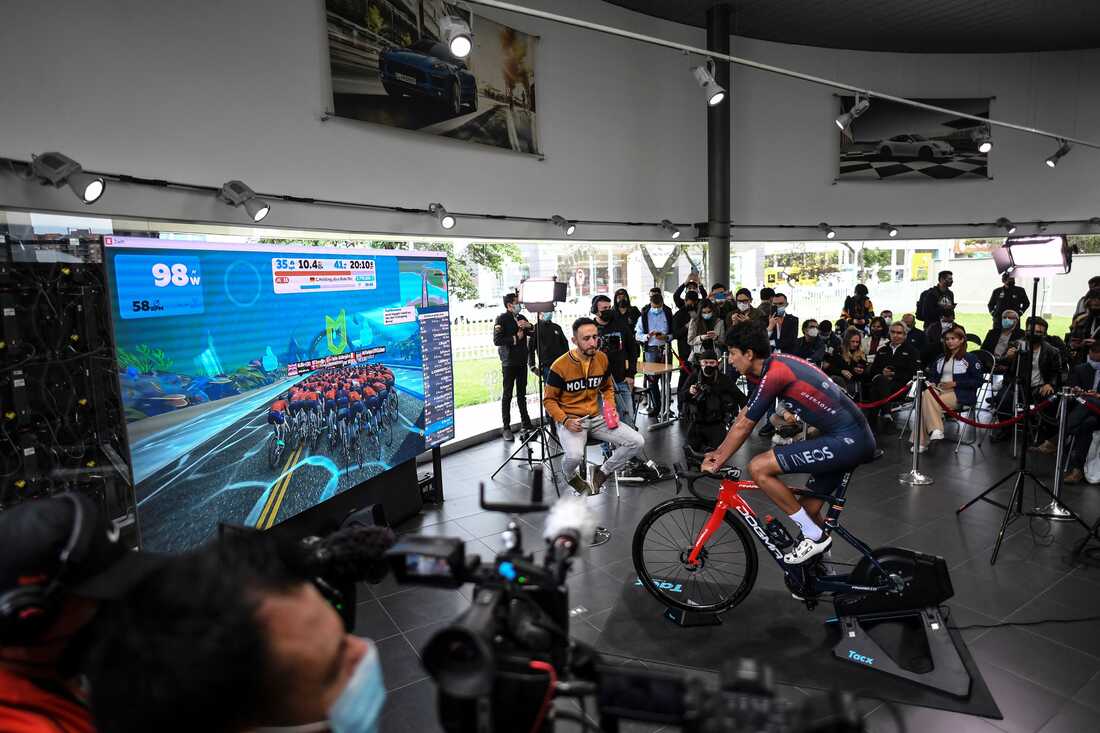
Colombian rider Egan Bernal , the 2019 Tour de France champion, holds a virtual test during a news conference in Bogota on April 2, 2022. JUAN BARRETO/Juan Barreto/AFP via Getty Images hide caption
Colombian rider Egan Bernal , the 2019 Tour de France champion, holds a virtual test during a news conference in Bogota on April 2, 2022.
Turning virtual racing into reality
According to Zwift, more than 16 million people in more than 130 countries saw the virtual races – on television and digital platforms. And viewership was equally split between the men's and women's events.
Longtime Tour de France organizer ASO — the Amaury Sport Organization — saw in those numbers the potential for women's cycling.
"That's how the conversation started," said Moolman-Pasio.
The conversation with Zwift was about launching a real women's Tour, one with heft and sustainability. A top-notch broadcast plan was critical.
"That's the key to the success of the race," said Kate Veronneau from Zwift, "to building that audience, to building future investment and growing the race and keeping it around."
Veronneau says broadcasting to 190 countries on each of the race's eight days should certainly help keep the new women's Tour de France around.
After so many other Tours had gone away.

Laurent Fignon, left, of France, and Marianne Martin of Boulder, Colo., hold up their trophies in Paris after winning the men's and women's Tour de France cycling races on July 23, 1984. Steven/AP hide caption
Trials, and lots of errors
In 1955, a five-stage loop from Paris to Normandy marked the first women's Tour de France. But it only lasted a year.
It wasn't until 1984 that organizers tried again.
A multistage event called the Tour de France Feminin ran for six years. It featured three wins for French cycling legend Jeannie Longo .
She won the last event in 1989. That Tour folded, like other versions after, because of uneven media coverage and sponsorship.
Both are there now.
Zwift won't say how much money it's poured into its four-year title sponsorship of the Tour de France femmes avec Zwift . But it's enough for about $250,000 in prize money, with $50,000 to the winner.
Finally seeing women
Moolman-Pasio is one of many veteran riders who've fought for a viable women's Tour de France. She's thrilled about finally getting to race in cycling's most prominent event, and about the girls and young women who'll be watching.
"Instead of sitting on the couch and watching the Tour de France and seeing men race up these epic climbs and fighting for the yellow jersey, finally they will see [women]," Moolman-Pasio said. "And it's the opportunity for them to recognize pro cycling as a career choice."
It's still a challenging choice, though.
Many female pro cyclists have to work as well as race.
Williams, the U.S. rider who thought virtual racing was dumb but now likes it so much she sometimes rides inside intentionally, was one of them. She's spent most of her five years as a pro working another job – as communications director for a bike registration network.
But the financial landscape is changing, and finally, Williams is a full time pro.
"This is the first year I've made a full salary from cycling," she said. "Now I actually have the opportunity to just race my bike, which I can't even tell you goes so far because not only is the training and racing incredibly demanding but the travel and the recovery require so much more of you than it did before."
The sport's governing body, the Union Cycliste Internationale (UCI), has been raising minimum salaries for women competing on professional teams. Team budgets are growing, as is prize money across the board. After the Tour de France femmes avec Zwift announced its record $250,000 purse, another women's grand tour event, the Giro d'Italia Donne, matched the Tour's prize money amount.
In her short professional career, Williams has won a World Championship gold medal and Olympic bronze in track cycling. She's excited about the upcoming Tour, a hallowed road race she watched every year, with her family, growing up.
A race now for women too.
"I think it's [part of] the general trend we're seeing everywhere," Williams said, "where women are gaining equal opportunity across the board in a lot of different areas of the world. So it's all kind of coming to a head. And I think the Tour de France is going to be such a great opportunity for us to showcase that as well."
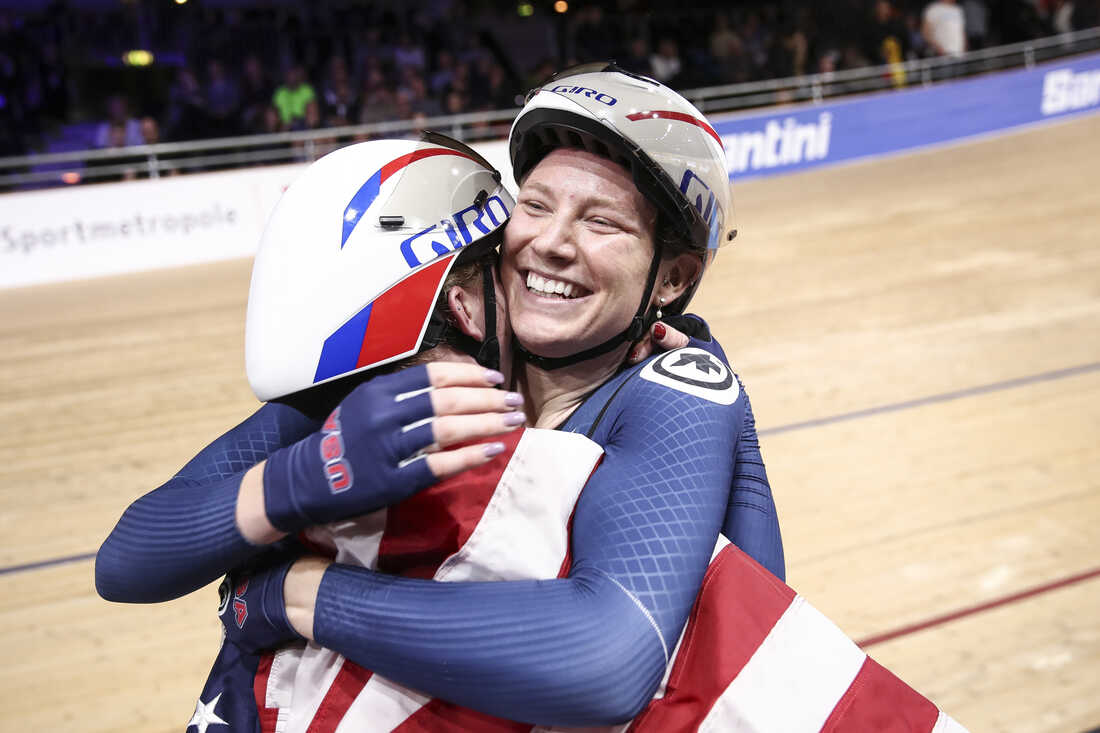
Lily Williams celebrates after the Women's Team Pursuit Finals during the second day of the UCI Track Cycling World Championships on Feb. 27, 2020, in Berlin. Maja Hitij/Getty Images hide caption
Lily Williams celebrates after the Women's Team Pursuit Finals during the second day of the UCI Track Cycling World Championships on Feb. 27, 2020, in Berlin.
Eight, for now
It will be a shorter showcase than the men's Tour.
Women's teams aren't big enough, at least for now, to support a 21-stage Tour de France like the men.
"The top women are more than ready to race three weeks," said Sadhbh O'Shea, a bicycle racing writer for VeloNews. "[But with] a good chunk of these riders working part time to fund their racing, until we can get a full peloton of professional riders, I don't think the women's sport is ready for a full three-week stage race."
But O'Shea thinks the eight-stage race starting Sunday is right for this initial effort.
With so much racing in the men's Tour, "you tend to get these dips in terms of the pace and aggression," O'Shea said. "Whereas with the women's racing, because it's shorter because there are fewer riders, it tends to be a little more gung-ho right from the start and all the way through. You do occasionally get lulls, but it tends to be more action, more of the time."
The women's stages average 80 miles, the men 99.
The action starts Sunday in Paris, before the men arrive for their finish, when the women will own the city streets. Their first stage begins at the Eiffel Tower – 12 laps, or 50 miles later — it ends on the Champs-Elysees. After the city, seven more stages of sprints, grueling mountain climbs and even sections of gravel and dirt roads.
By the end, on July 31, the new women's Tour hopes to finish with new fans, and a promise to be back – year after year.
clock This article was published more than 1 year ago
The Tour de France finally features women again — after 33 years
After a 33-year hiatus, women have returned to the world’s most-watched sporting event : the Tour de France.
On Sunday, 24 teams of six cyclists each lined up on the Champs-Élysées in Paris to begin the eight-day Tour de France Femmes avec Zwift . The 640-mile stage race features two mountain stages and ends in the Vosges Mountains. In the 119-year existence of the men’s tour, women have competed in the official Tour de France only five times. The women’s tour lasted from 1984 to 1989 — and then was canceled because of a lack of financial backing. A women’s one-day race called La Course emerged recently, but some riders have said that it has been more of an insult than an opportunity.
This year, the women’s race was kick-started by sponsor Zwift, a cycling app, and will be one of the highest prize purses — around 250,000 euros in total — in women’s cycling racing history.
“For the women to take the stage, to be elevated through that platform that they deserve, is really the key to unlocking so much more audience, investment and growth in the sport at all levels,” said Kate Veronneau, Zwift’s director of women’s strategy and a former pro-cyclist. “For little girls growing up and seeing themselves in a variety of sports … that’s powerful.”
When U.S. cyclist Marianne Martin won the first women’s Tour de France in 1984 at 26, things looked a lot different for female cyclists. Notably, she had neither salary nor radio. During one stage race in Grenoble, France, she rode ahead of the pack for over 30 miles, she said.
“I didn’t know where they were, so I just pushed ahead, thinking, ‘They’re gonna catch me,’ ” Martin, now 64, recalled. But they never did. The 10 minutes she gained on the peloton during that pivotal stage race, she says, gave her the confidence to win the entire Tour — which was then an 18-stage race covering just over 600 miles.
When Martin was competing, widespread interest in women’s sports was limited. But that world looks different now.
“Women’s sports is trending hard because the companies that have invested in sports are seeing fabulous returns,” Veronneau said. Indeed, as The Washington Post has reported , female athletes are garnering more attention from fans and marketers — which is leading to a belief that women are one of the best investments in the sports industry.
Women’s sports can do at least one thing men’s can’t, experts say: Get bigger
“Female athletes take their responsibility to be role models extremely seriously because they have to fight for every sponsorship dollar that they have,” Veronneau added. “They know everything they do is going to impact the opportunities that come after them.”
The majority of the 2022 female cyclists riding the Tour are under 35; most have never had the opportunity to watch other women ride this race.
U.S. Human Powered Health team cyclist and Olympic bronze medalist Lily Williams, 28, was inspired to start cycling after watching the men’s Tour de France on TV every summer with her family.
“I think certainly if there had been a women’s Tour de France, I would have started cycling a lot earlier,” Williams said, adding that she only started cycling a couple of years ago. “And I think my career arc would look a lot different.”
Williams said her mom, speed skating Olympian Sarah Docter, was a pro-cyclist in the 1980s who never had the chance to ride the Tour. “She got burned out really early,” Williams said. “A lot of that is probably due to the complete lack of support that women’s sports had back at that time.”
One crucial piece of support is a salary. This is the first year that Williams is riding as a professional cyclist without also having to work. “It’s been huge to have that time to rest and recover. That completely changes the sport when you have 10 or 20 teams of riders who are being paid a living wage,” she said.
But not all female cyclists in the Tour de France receive a salary. Only 14 of the 24 teams competing in the Tour are licensed under the Union Cycliste Internationale (UCI) Women’s WorldTeams Tour, which requires teams to provide a minimum salary of 27,500 euros per year to each rider.
“It’s a very new concept for women professional cyclists to earn a required minimum salary,” Veronneau said. “The best of the best are making good money these days, but for most pro women, it’s still squeaking by and a challenging career choice. Most often have to work secondary jobs alongside their training of 25 to 30 hours per week.”
Zwift is funding a total prize purse for the women’s race of 250,000 euros, with 50,000 going to the winner. The men’s prize purse is 2.3 million euros, with 500,000 going to the winner. Compared with 1984, this is a 10-fold improvement in the women’s to men’s prize winnings ratio. Martin recalls winning less than $1,000 compared with the $100,000 the 1984 male champion, Laurent Fignon, took home.
Race organizers say the goal is to grow women’s cycling to the point where full parity is possible, but they are starting with what is most sustainable first. For now, that means eight stages instead of the 21 stages that men ride. Women’s cycling teams are smaller than men’s, Williams explained, making 21 stages exceptionally more difficult for the women’s teams to commit to from a financial, staffing and physical standpoint.
Williams also says that eight stages with shorter races allows the women’s races to be more dynamic, less predictable, and thus more exciting to watch.
“Every day in the men’s tour, there’s a four-to-six-hour race [in which] a group goes off the front to get media exposure, and then they’re reeled in, and the general classification contenders maintain their position,” she said. “In women’s racing, where races are three to four hours, people are fresher to attack throughout the race; breakaways might have a chance to stick. You have a wide variety of women who could be winning the race.”
Regardless of numbers, riders say the Tour de France Femmes avec Zwift is a game changer for women’s cycling and will serve as an inspiration for young women and girls worldwide watching the event.
“We need the media to show more women in sports so that girls think about more options,” Martin, the former pro cyclist, said. “I mean, if they only see women in fashion, they’re going to only think about fashion. If they see women in sport, and it’s exciting, they’re going to see that as an option.”

Why Did It Take This Long to Get a Women's Tour de France Back on the Calendar?
Well, for starters, apathy, laziness, and sexism had something to do with it.
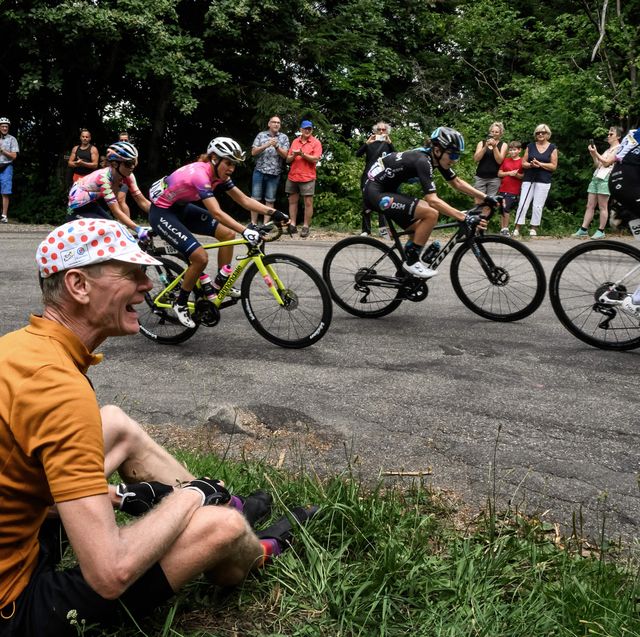
Seeing an opportunity to combine history and humor, I started answering, “Yes, I’ll be at the first women’s Tour de France, which was in 1955, as soon as my time machine is ready. I’m working on my DeLorean, just waiting on the flux capacitor.” After launching into a brief lesson on women’s inclusion—then banning, then re-inclusion and rebranding—at Le Tour, I usually get some version of this reaction: Wait… Why did the women’s Tour de France races go away, and why did the comeback take so long?
The distilled answer: The reason ASO took so long to bring a stage race back to the Tour de France was apathy, laziness, and sexism. But I believe this year is different. We can absolutely make Tour de France Femmes stick around and, better still, grow.
In 1955—more than 50 years after the first men’s Tour de France—women made their own Tour de France debut with a five-day stage race. Jean Leulliot, the race director, invited 41 cyclists to participate, with the intent of proving that women couldn’t possibly ride such a distance at such a prestigious race. After he was proved wrong, he is reported to have said, “I will never organize this race again... The women are different from men.” The event was dismissed as a “stunt race,” and the women’s race was discontinued for almost 30 years.
During that three-decade interval, British cyclist Eileen Gray successfully lobbied for the inclusion of women in other major cycling events, and ASO began to pay attention again. The 1984 Tour de France race codirector, Félix Lévitan, created an 18-day race for the women—Tour de France Féminin—which ran on the same days as the men’s event. The women’s stage distances were shortened so both men’s and women’s pelotons could roll through without impeding either event. Indeed, crowds flocked to the roadsides and mountaintops, thrilled to see two pelotons roll by.
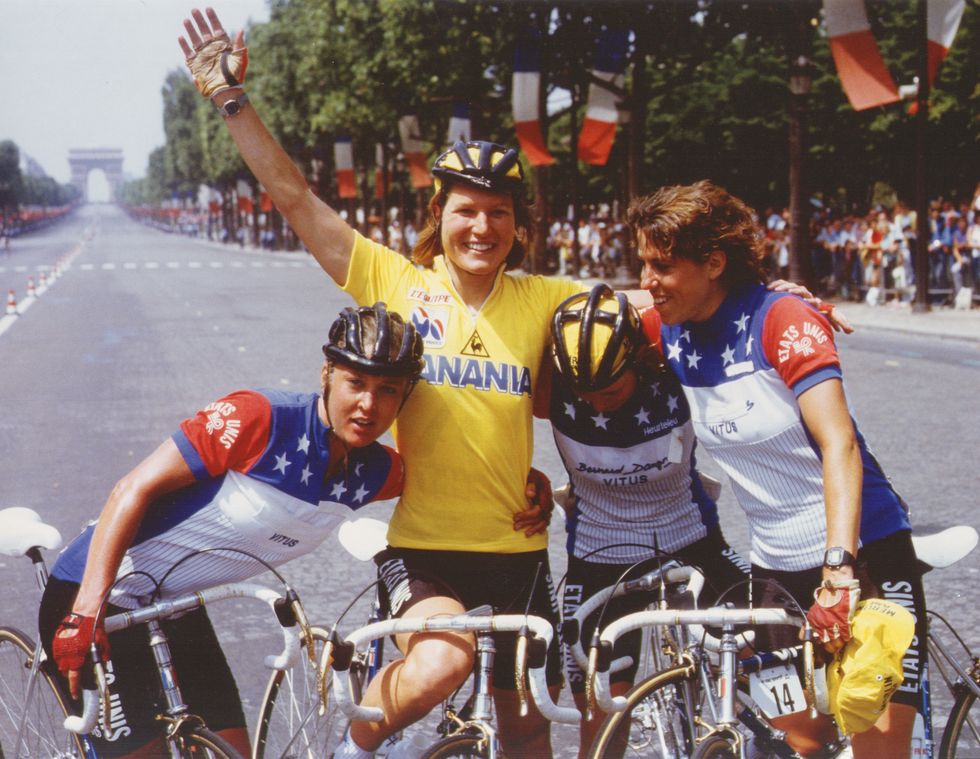
But the following year, in 1985, UCI—Union Cycliste Internationale, the sport’s governing body —passed a rule that no women’s race could be longer than 12 days or involve “excessive distances.” Lévitan tried to skirt this rule, but ASO wasn’t impressed. It let him go as race director in 1987, and the subsequent director, Jean-Marie Leblanc, discontinued the women’s race after 1989.
ASO also banned other race directors from creating a separate Tour de France for women, as it would not grant access to the name “Tour de France.” Other race directors tried to fill in the gap in the 1990s with such races as Tour of the EEC Women, Tour Cycliste Féminin, and Grande Boucle Féminin Internationale, but sponsorship was sparse. It wasn’t the Tour de France brand, and the other names just weren’t marketable.
For years I pestered ASO on my own and got no response. It made no sense to me, an aspiring pro cyclist in 2009, that no women were at the pinnacle race in professional cycling. And as a journalist and filmmaker, I began filming the documentary Half the Road in 2012 and interviewed superstar athletes Emma Pooley, Marianne Vos, and Chrissie Wellington. They all affirmed that they wanted to see—and race—a Tour de France for women.
So we banded together and created Le Tour Entier (“the whole tour” needs women too), as a pressure group to target ASO. It was a website, manifesto, and business plan to bring women back to the Tour de France. We created a petition for our cause in 2013 on Change.org that gained nearly 100,000 signatures. The media became our allies, hounding ASO leadership for a response. At first, ASO ignored us. But not forever.
In September 2013, we had a secret meeting with ASO to establish a women’s race. We were under a gag order that prevented us from discussing the work being done; ASO negotiators wanted complete control to promote a narrative that any efforts to include women in the Tour would be due to their hard work. (ASO isn’t exactly into sharing credit with women. To this day, we’re still not acknowledged anywhere on ASO’s sites.)
From October 2013, we worked diligently behind the scenes with ASO, secured “Tour de France” naming rights, created the course, set the team invitation structure, planned the marketing, obtained TV rights, and in 2014 ultimately built La Course by Le Tour de France, marking the third time a women’s race would be held at the Tour de France.
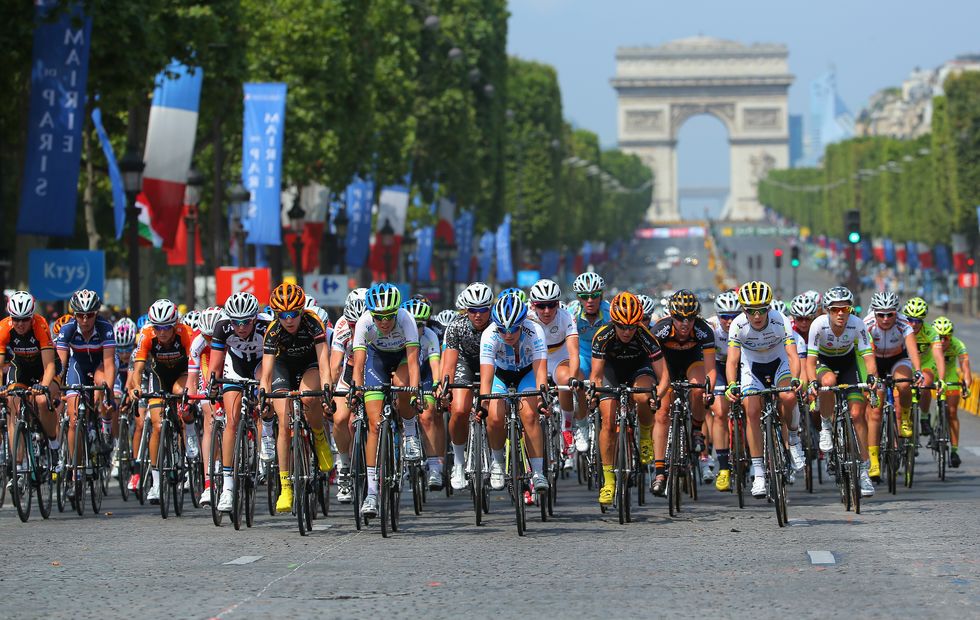
The bad news: The race would be shorter than it was in 1955 and 1984–1989. ASO officials were too apprehensive to believe that viewers would watch women’s racing, so they allowed one day only. The good news: The naming rights were back, and the race was in place the very next year after our petition. La Course, held for a single day of racing, ran from 2014 through 2021. And this year it morphed into the eight-day Tour de France Femmes avec Zwift.
When we created La Course by Le Tour de France, we requested that the race be augmented annually by three to five days until it reached equity with the men’s 21-day race. In 2014, ASO verbally promised that it would add more days to La Course. Then it did nothing. For eight years .
Despite wide viewership in 2014 for the first La Course—it was broadcast in 157 countries and on 25 different networks—and despite the demands from fans for more coverage and requests from riders for more stages, ASO was content to keep the women’s one-day presence as a token gesture. After all the (voluntary) work we did in creating La Course, I approached ASO in 2015 with a more sustainable plan. “We need to grow the number of days. Hire me to seek sponsorship and investors for a full-fledged women’s stage race,” I said.
“We do not have that position,” said ASO’s director of Marketing and Business Development at the time.
“Exactly. So let’s create that position.”
“We’re, uh, not hiring… but if you do find investors, please send them our way.”
While La Course by Le Tour de France remained a single-day event for the next eight years, ASO’s profit margin steadily increased. The Amaury family—the “A” of ASO—takes home €30 million annually, roughly equal to $30 million as of this writing. (Keep those multimillion profits in mind as you hear ASO proclaim that its €250,000 prize purse at Tour de France Femmes will be the biggest ever in women’s racing! )
Which brings us to equality math: The men’s prize purse at the end of 21 days is €2,282,000. Eight days of men’s racing totals €869,333. So the €250,000 payout for the women’s eight-day race? That’s just 29 percent of what men earn at the Tour de France. ASO has the resources to change this percentage, just as we have the resources to keep the pressure on until that happens.
While it would be easy to wallow in this inequity and in the ASO’s indifference, the future of women’s cycling is getting brighter at the Tour de France. Zwift committed to a four-year sponsorship of Tour de France Femmes. Viewership is on the rise. The female pro peloton is at its strongest. If we band together as fans, patrons, and voices for change, the future of women’s cycling at Le Tour is brighter still.
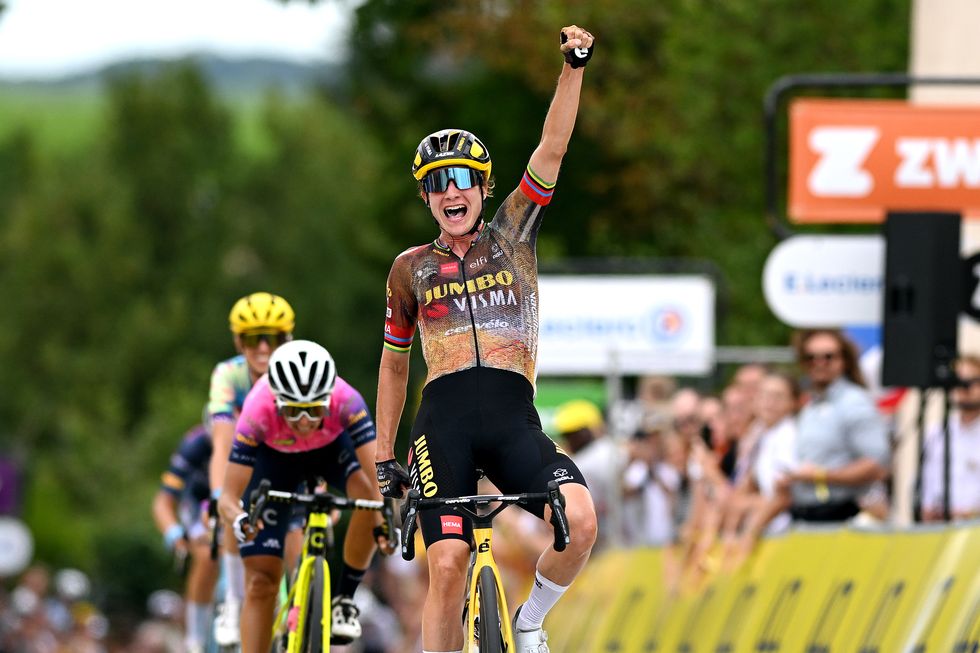
Together, we can take an active role in making Tour de France Femmes stick around for a long, long time. Here’s how we can all make a difference:
- Turn on your TV or streaming device; views and metrics matter. If your provider offers coverage of the men’s race and not the women’s, let that provider know you want to watch the women and that you’ll cancel your subscription if it doesn’t oblige by 2023.
- Buy products of the sponsors: Liv Bicycles, Tissot, Shimano, Strava, Skoda, Century 21, and a few more here . Tell them your patronage is because they support Tour de France Femmes.
- Be a social media warrior. Share, like, and post on Instagram, Facebook, Twitter, and TikTok about why the women’s race is so awesome.
- Want to express your views on the awesomeness of women at Le Tour and/or the inequity still at play? Do it, but if you want to see real progress, be kind and professional. Write, call, contact ASO .
If we stand united supporting the 2022 Tour de France Femmes avec Zwift this July 24–31, I firmly believe we won’t see any ASO cancellations or subsequent reincarnations of women’s races at the Tour de France. Let’s celebrate the progress, but keep pushing for equity. ASO may be slower than molasses, but 50 years from now, I believe women will race equal days to men at the Tour de France. And yes, I will absolutely be on that future start line. My DeLorean is almost ready.
Kathryn Bertine is an author, activist and retired pro cyclist. She is the founder of Homestretch Foundation , a non-profit, charitable organization dedicated to ensuring equity for women in sport. Her recent book, STAND , was a 2x finalist for Next Generation Indie Book Awards. Facebook & Twitter: @KathrynBertine; Instagram: @kathryn_bertine; Web: www.kathrynbertine.com .

.css-1t6om3g:before{width:1.75rem;height:1.75rem;margin:0 0.625rem -0.125rem 0;content:'';display:inline-block;-webkit-background-size:1.25rem;background-size:1.25rem;background-color:#F8D811;color:#000;background-repeat:no-repeat;-webkit-background-position:center;background-position:center;}.loaded .css-1t6om3g:before{background-image:url(/_assets/design-tokens/bicycling/static/images/chevron-design-element.c42d609.svg);} Member Exclusive
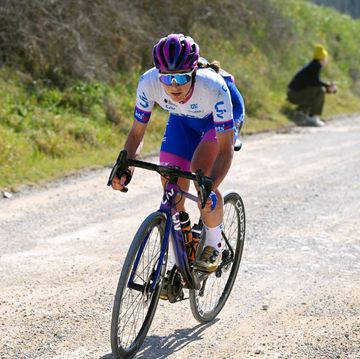
Hill Repeats to Help You Dominate Mountain Races
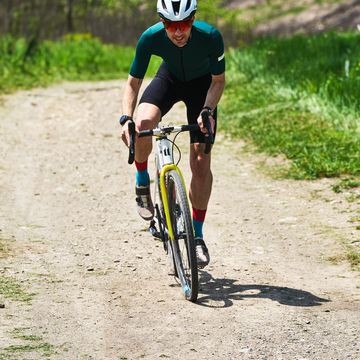
12-Week Gravel Training Plan

How to Tell if You’re Ready for a Century Ride

The Top 12 Dos and Don’ts of Buying A New Bike

Are Hookless Wheel Systems Safe On the Road?
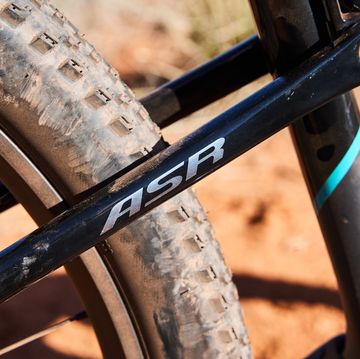
Yeti ASR XC Mountain Bike Review

The 6 Best Things We Saw at Philly Bike Expo
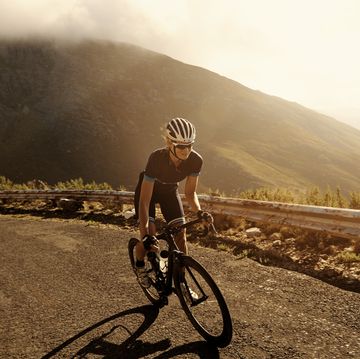
15 Ways to Cycle Faster
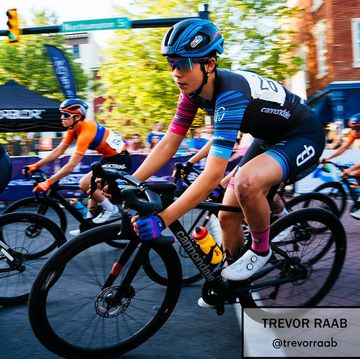
Race the Easton Twilight Criterium With Bicycling
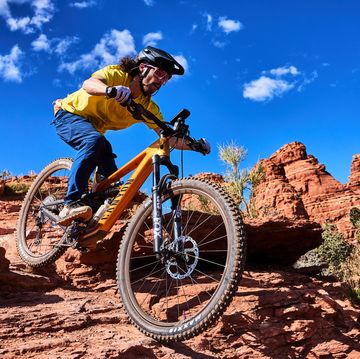
Cycling-Specific Stretch and Strength Routine

How to Improve Cadence, According to Pros
- aller au contenu principal
- aller au menu de navigation
- aller au moteur de recherche
- aller à la page Direct radio
Tour de France femmes : l'histoire mouvementée entre la Grande Boucle et les coureuses
Après une première tentative en 1955, les femmes n'ont vraiment eu une course s'apparentant au Tour de France masculin qu'entre 1984 et 1989.
La route a été longue, mais le Tour de France rattrape un insensé retard. Après des années d'absence, une Grande Boucle féminine voit de nouveau le jour. La fin d'une interminable anomalie, en partie liée à de vieux préjugés machistes.
En 1987, sur le plateau d'"A chacun son Tour" , lors d'un début particulièrement tendu, Marc Madiot déclarait ainsi face à Jeannie Longo qu'il y avait "des sports qui sont masculins, des sports qui sont féminins. Voir une femme danser, pour moi, c'est très joli. Voir une femme jouer au football, c'est moche, voir une femme sur un vélo, c'est moche… " .
Trente-cinq ans plus tard, le Tour de France femmes semble enfin pouvoir prendre toute sa place après plusieurs essais. Franceinfo: sport revient sur près de 70 ans de tentatives infructueuses pour que les coureuses aient leur propre Grande Boucle.
1955 : une première édition oubliée
C'est dans la France des années 1950 que la première édition d'une grande boucle féminine est lancée. L'idée vient de Jean Leulliot, ancien journaliste de l'Auto , puis plume du canard collaborationniste La France socialiste pendant l'Occupation. Organisateur du Circuit de France (une sorte de Tour de France bis) pendant la guerre, il avait d'ailleurs menacé le champion de France de l'époque d'une visite de la Gestapo en cas de non-participation à son épreuve.
Pourtant, Jean Leulliot a été soutenu par la presse sportive après la Libération malgré sa collaboration. Réhabilité, il imagine dix ans plus tard une épreuve féminine. A l'époque, les championnats du monde ne sont même pas encore ouverts aux femmes (il faudra attendre 1958), et l'on ne décerne un titre de championne de France que depuis quatre ans. Leulliot dessine une épreuve de 400 km, parcourus en 5 étapes, avec une quarantaine de partantes. On parle alors de "coursières" , propices aux "crises de nerfs" sur leur selle, et moins à l'aise que dans leurs "travaux ménagers" . La Britannique Millie Robinson s'impose dans cette course sans lendemain en 1955. Jean Leulliot aura plus de réussite dans son projet de relancer Paris-Nice.
1984-1989 : les années dorées
Il faut attendre presque trente ans pour voir les cyclistes féminines de retour. Cette fois, c'est la Société du Tour de France (ancêtre d'ASO) qui prend les choses en main, sous l'impulsion de son président d'alors, Félix Lévitan. Déjà à l'origine du maillot à pois et de l'arrivée sur les Champs-Elysées, le journaliste veut devancer le machisme qui règne alors dans le monde du cyclisme. Un an avant la création de son Tour féminin, il déclare, comme le rappelait l'ancien directeur du Tour Xavier Louy au magazine Pédale de juin 2019, que "la femme est l'égale de l'homme, quand elle ne lui est pas supérieure. Aussi avions-nous pensé organiser quelque chose de plus important que tout ce qui s'était fait jusqu'à présent pour les femmes dans le cyclisme.”
En 1984, Lévitan gagne son bras de fer. Six équipes de six coureuses se lancent dans la Grande Boucle en lever de rideau des hommes. D'abord snobée par les deux stars du moment (Maria Canins et Jeannie Longo), l'épreuve trouve difficilement sa place dans un milieu machiste. Les étapes raccourcies des femmes sont sujettes aux moqueries, y compris sur les plateaux de télévision. En 1986, un an avant les attaques de Marc Madiot, Laurent Fignon s'en prend lui aussi à Jeannie Longo lors de la même émission. "Je ne suis pas intéressé par le cyclisme féminin (...) Je trouve que ce n'est pas un sport esthétique. Je comprends qu'on ait envie de faire du vélo quand on est une femme mais moi, je préfère ne pas regarder…", lâche le coureur devant une Longo à qui il n'aurait même pas daigné dire bonjour à son arrivée sur le plateau.
Deux ans après le départ de Félix Lévitan et la prise de pouvoir de Jacques Chancel, peu connu pour son estime du cyclisme féminin, le Tour de France féminin disparaît en 1989. Pourtant, le duel entre Maria Canins (sacrée en 1985 et 1986) et Jeannie Longo (sacrée en 1987, 1988 et 1989) anime une course qui prend de l'ampleur. Prétextant une logistique parallèle à celle des hommes ingérable, la Société du Tour de France baisse le rideau et renvoie le peloton féminin à l'ombre.
1992-2022 : échecs et retour en grâce
Pour entretenir la flamme naissante, un organisateur indépendant, et donc concurrent, se lance dans l'aventure en 1992. Pierre Boué crée la Grande Boucle féminine internationale. Ne pouvant utiliser les appellations "Tour" et "maillot jaune", propriétés d'ASO, il instaure le maillot or. Mais la sauce ne prend pas, alors que l'affaire Festina plombe le monde du cyclisme en 1998. Les critiques récurrentes des coureuses sur les hôtels, les longs transferts, les neutralisations de course et les primes non versées minent l'épreuve, à laquelle ASO voue également une guerre ouverte. Déclassée par l'UCI en 2005, l'épreuve disparaît en 2009 sans jamais s'être imposée.
En 2005, la fédération internationale lance donc un appel à candidatures pour une course à étapes majeure en France. La Route de France féminine voit le jour, sous la direction d'Hervé Gérardin, un ancien d'ASO désormais à la tête de sa propre organisation. Malgré le soutien de l'UCI, elle reste sous-médiatisée et fait face à des difficultés d'organisation. Avant sa disparition en 2016, elle est néanmoins une rampe de lancement pour plusieurs coureuses de renommées dont Annemiek van Vleuten, gagnante en 2010.
Après des années d'attente, et notamment grâce à la pression de David Lappartient, président français de l'UCI, ASO a relancé la machine cet été. Après avoir introduit la Course by le Tour ces dernières années, la société à la tête du Tour de France a remis les pendules à l'heure. Un retournement de situation surprise, si l'on se rappelle les déclarations de Christian Prudhomme en 2019 sur Europe 1 "La grandeur du Tour fait que nous ne sommes pas capables d'organiser une autre course pendant le Tour , avait-il affirmé. Que ce soit une course des moins de 6 ans, des plus de 80 ans, des droitiers ou des gauchers, ce n'est pas possible" . Pendant, non, mais après, c'est possible. Enfin.
Partager : l'article sur les réseaux sociaux
La Quotidienne Sport
Recevez à 8h30 notre sélection de l’actualité sportive : articles, résultats, vidéos...
Découvrez nos newsletters
les mots-clés associés à cet article
- Tour de France femmes 2024
- Tour de France 2024
Commentaires
Connectez-vous à votre compte franceinfo pour participer à la conversation.
Toute l’actu en direct et en continu, où et quand vous voulez.
- Sauvegardez vos articles à lire plus tard
- Recevez les alertes uniquement sur ce qui vous intéresse
Tout France Info, et bien plus. Sauvegardez vos articles à lire plus tard et filtrer l’actualité qui vous intéresse
Tour de France Femmes past winners
A full list of champions dating back to the first version in 1955 and the original women's Tour de France stage race held from 1984-1989
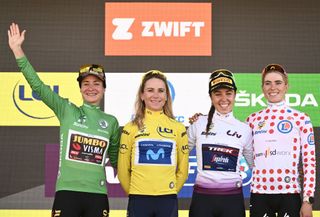
Tour de France Femmes: 2022 - present
The first edition of the rebirth of the Tour de France Femmes, launched under the organisation of ASO, was an eight-day race that began on the Champs-Élysées in Paris and end on La Super Planche des Belles Filles where Annemiek van Vleuten (Movistar) was crowned the overall champion in 2022.
The second edition of the Tour de France Femmes in 2023 will be held across eight days with a route that begins on July 23 in Clermont-Ferrand and finish on July 30 in Pau.
Cyclingnews will have live coverage of all eight stages of the 2023 Tour de France Femmes avec Zwift , along with race reports, galleries, results, and exclusive features and news.
Subscribe to Cyclingnews for unlimited access to our coverage of women's cycling.
- You’ve come a long way, baby - Vital statistics show sea change in women’s cycling
- Marianne Martin: Remembering the magic of the 1984 women's Tour de France
- La Grande Boucle, La Course and the return of the women's Tour de France
La Course by Le Tour de France: 2014-2021
La Course by Le Tour de France was created in 2014 following a petition to ASO calling for a women's Tour de France. Le Tour Entier's petition was led by Kathryn Bertine, Marianne Vos, Emma Pooley and Chrissie Wellington and secured 97,307 signatures. The event was held across various platforms from a one-day to a multi-day event between 2014 and 2021.
La Course, though controversial, had become one of the most showcased events in the Women's WorldTour, and although the wait was longer than anyone anticipated, it finally became the stepping stone to the Tour de France Femmes avec Zwift in 2022.
Grande Boucle Féminine Internationale: 2000-2009
A prominent women's stage race in France, not run by ASO, the Tour Cycliste Féminin had started in 1992, and the re-named Grande Boucle Féminine Internationale until it came to an end in 2009.
Pierre Boué organised the Tour Cycliste Féminin and the Grande Boucle, and although it was not the women's Tour de France, it was one of the most prominent women's stage races of that period, and widely regarded as a women's French Grand Tour.
Tour Cycliste Féminin
A women's stage race in France, not run by ASO, took place as the Tour Cycliste Féminin in 1992-1997, before changing names to Grande Boucle Féminine from 1998-2009.
Women's Tour de France: 1984-1989
The women's peloton raced their first official launch of the women's Tour de France stage race until 1984 won by American Marianne Martin . It was an 18-day race held simultaneously as the men's event and along much of the same but shortened routes with shared finish lines. The Société du Tour de France, which later became part of ASO in 1992, managed both men's and women's events.
Normandy - 1955
The men's Tour de France is rich in history, with its beginnings in 1903. A women's version found its roots much later, and under a different organisation, as a one-off multi-day race won by the Isle of Man's Millie Robinson in Normandy in 1955.

Thank you for reading 5 articles in the past 30 days*
Join now for unlimited access
Enjoy your first month for just £1 / $1 / €1
*Read any 5 articles for free in each 30-day period, this automatically resets
After your trial you will be billed £4.99 $7.99 €5.99 per month, cancel anytime. Or sign up for one year for just £49 $79 €59

Try your first month for just £1 / $1 / €1
Get The Leadout Newsletter
The latest race content, interviews, features, reviews and expert buying guides, direct to your inbox!

Kirsten Frattini is the Deputy Editor of Cyclingnews , overseeing the global racing content plan.
Kirsten has a background in Kinesiology and Health Science. She has been involved in cycling from the community and grassroots level to professional cycling's biggest races, reporting on the WorldTour, Spring Classics, Tours de France, World Championships and Olympic Games.
She began her sports journalism career with Cyclingnews as a North American Correspondent in 2006. In 2018, Kirsten became Women's Editor – overseeing the content strategy, race coverage and growth of women's professional cycling – before becoming Deputy Editor in 2023.
Gent-Wevelgem 2024 - Analysing the contenders
Kool comes up short in Classic Brugge-De Panne sprint despite polished lead-out
Chris Harper raises the 2024 bar again as team leader at Volta a Catalunya
Most popular.
By Cyclingnews February 21, 2024
By Cycling News February 21, 2024
By Cycling News February 18, 2024
By Cycling News February 04, 2024
By Cycling News February 01, 2024
By Cycling News January 31, 2024
By Cyclingnews January 31, 2024
By Cycling News January 25, 2024
Latest on Cyclingnews
Stuyven, lidl-trek delighted with second behind 'on another level' van der poel at e3, matteo jorgenson, visma-lease a bike endure rough series of events at e3 saxo classic, under-23 world champion axel laurance makes breakthrough with win at volta a catalunya.
APPLICATIONS FOR THE 2024 CYCLE CITY LABEL ARE OPEN
2023 edition.
- Stage winners
- All the videos
Tour Culture
- Commitments
- KEY FIGURES
- Sporting stakes
- Maillot Jaune Collection
- Photos & vidéos

2028 : the future remains green with Škoda
Discover the 2024 route.

Grand Départ Rotterdam 2024

DISCOVER STAGE 5 ON STRAVA

2023 rankings

Stage 1 | 08/12 Rotterdam > La Haye
Stage 2 | 08/13 dordrecht > rotterdam, stage 3 | 08/13 rotterdam > rotterdam, stage 4 | 08/14 valkenburg > liège, stage 5 | 08/15 bastogne > amnéville, stage 6 | 08/16 remiremont > morteau, stage 7 | 08/17 champagnole > le grand-bornand, stage 8 | 08/18 le grand-bornand > alpe d'huez, tour culture, grand départ rotterdam 2024, elles arrivent, femmes du tour - justine ghekiere (ep.11), our commitments, "maillot jaune" collection, the tour's news, accessories.
Get exclusive information about Le Tour de France Femmes
General Ranking
> Withdrawals

Privacy and cookies policy
Your gdpr rights.

IMAGES
COMMENTS
Marianne Martin is the winner of Tour de France féminin 1984, before Heleen Hage and Deborah Schumway. Connie Meijer is the winner of the final stage.
The pioneers of the Women's Tour de France 1984 (Image credit: ... once again, compete for the prestigious yellow jersey at the Tour de France Femmes avec Zwift from July 24-31. The eight-day race ...
Marianne Martin stands alongside fellow Tour de France winner Laurent Fignon on the podium in Paris on July 22, 1984. Martin received around $1,000 for her win; Fignon got more than $100,000 ...
Et c'est ainsi, que le 22 juillet 1984, Marianne Martin monte sur le podium, aux côtés de Laurent Fignon, rayonnants tous les deux devant la foule et les médias du monde entier. L'image est puissante, une femme et un homme côte à côte, tous deux en jaune, tous deux vainqueurs du Tour de France.
Two-time Tour Féminin winner Maria Canins climbs the Col d'Izoard during the 1986 race. The 1984 edition, held in the same summer as the inaugural women's road race at the Olympic Games, took place over 18 days, with the women riding shortened versions of the men's stages, including the iconic Alpine and Pyrenean passes such as the brutal Col de Joux Plane, earlier in the day.
Marianne Martin's 1984 Tour de France was a world apart from today's Tour de France Femmes. Cycling Weekly. EST. 1891. US Edition ... "I think [the 1984 Tour de France Féminin] was a little bit ...
1984-1989: Tour de France Féminin In 1984, there were two winners of the Tour de France: Frenchman Laurent Fignon and Marianne Martin of the United States. ... and riding from Torino to Nice after the inaugural Tour de France Femmes. In the summer, she loves to run, ride, and hike through the Elk Mountains in her backyard; in the winter, she ...
The trophy celebrated Martin's first-place finish in the first Tour de France Feminin in 1984—the women's Tour de France— making her the first woman and first American to win the Tour. 13 ...
As a 26-year-old, Martin won the inaugural Tour de France Féminin in 1984, two years before fellow American Greg LeMond became the first non-European rider to win the men's race since it was ...
Stage 12 » La Chapelle-en-Vercors › Grenoble (73.8km) Marianne Martin is the winner of Tour de France féminin 1984 Stage 12, before Heleen Hage and Judith Painter. Heleen Hage was leader in GC.
Twenty-five years on from the start of Cyclingnews, an ASO-run women's Tour de France, of the kind that existed from 1984-1989, takes place from July 24-31 in 2022 at the Tour de France Femmes ...
The Tour de France Femmes ... After a one off event in 1955, an equivalent race to the Tour de France for women was held under different names between 1984 and 2009. Over the years, these races struggled with financial difficulties, limited media coverage, sexism and trademark issues with the organisers of the Tour de France. ...
Produced by women filmmakers, the independent film Uphill Climb: The Women Who Conquered The Impossible Race is a documentary of the original 1984—1989 Tour de France Féminin. Slated to premiere in Spring 2023, Uphill Climb tells the untold story of the female competitors, why the race stopped, and how, decades later, that race paved the way ...
It wasn't until 1984 that organizers tried again. ... After the Tour de France femmes avec Zwift announced its record $250,000 purse, another women's grand tour event, the Giro d'Italia Donne ...
Pioneers of women's cycling in Paris for 2022 Tour de France Femmes (Image credit: Kirsten Frattini) Joining the riders on their trip to Paris is Liggett, who was the British team's manager and ...
By. July 24, 2022 at 10:42 a.m. EDT. Marianne Martin, in the yellow jersey, winning the first women's Tour de France in 1984. (Courtesy of Marianne Martin) 6 min. After a 33-year hiatus, women ...
The 1984 Tour de France race codirector, Félix Lévitan, created an 18-day race for the women—Tour de France Féminin—which ran on the same days as the men's event.
Après une première tentative en 1955, les femmes n'ont vraiment eu une course s'apparentant au Tour de France masculin qu'entre 1984 et 1989.
The 1984 Tour de France was the 71st edition of the Tour de France, run over 4,021 km (2,499 mi) in 23 stages and a prologue, from 29 June to 22 July.The race was dominated by the Renault team, who won the team classification and ten stages: Renault's French rider Laurent Fignon won his second consecutive Tour, beating former teammate Bernard Hinault by over 10 minutes.
From 1984, a women's Tour de France was staged consistently, although the name of the event changed several times - such as Tour de France Féminin, Tour of the EEC Women, Tour Cycliste Féminin and Grande Boucle Féminine Internationale. ... The Tour de France Femmes does not succeed these historic races, with ASO stating that the 2022 race is ...
A full list of champions dating back to the first version in 1955 and the original women's Tour de France stage race held from 1984-1989
Although the Tour de France Femmes is the richest race on the women's calendar boasting €250,000 total prize money, it is a mere fraction of the men's €2.2 million prize pot, while the ...
Tour de France Femmes 2024 - Official site of the race from the Tour de France Femmes. Includes route, riders, teams, and coverage of past Tours. APPLICATIONS FOR THE 2024 CYCLE CITY LABEL ARE OPEN. SEE MORE. Club 2024 route 2023 Edition Rankings Stage ...
The 2024 Tour de France will be the 111th edition of the Tour de France.It will start in Florence, Italy on 29 June, and will finish in Nice, France on the 21 July.The race will not finish in (or near) Paris for the first time since its inception, owing to preparations for the Paris 2024 Olympic and Paralympic Games.